Electric boats
Silent yachts, silent yachts launches solar catamaran with kite wing sail and 100 mile daily range from the sun.
Solar boat engineer and designer Silent Yachts has shared new details of the SILENT-60, a 60′ catamaran with 42 solar panels and two electric propelled motors backed by 286 kWh of battery capacity. While Silent Yachts’ solar-powered vessels are all unique, the SILENT-60 will also be fitted with a 9-13 square meter kite wing, generating additional clean power to pull the yacht.
Silent Yachts was founded by Heike and Michael Köhle, who together have sailed over 75,000 nautical miles around the world, and decided there had to be a better way to propel yachts with clean energy.
After beginning research into solar yacht technologies in 2004, Silent Yachts gathered five years of sailing data and constructed its first fully self-sufficient solar-powered catamaran , the Solarwave 46.
After a five-year trial at sea that began in 2010, Silent Yachts had a proven solar yacht concept, and began serial production of luxury sustainable vessels in 2016 with the SILENT-64. By 2018, The SILENT-64 had become the first serial-production solar-powered bluewater catamaran to cross the Atlantic, from Cartagena, Spain to Barbados in 16 days.
In 2020, the company announced a partnership with Volkswagen Group , which will supply all the components and batteries for a new 50-foot yacht. The yacht will be designed with the help of Cupra, and will utilize VW’s MEB Platform.
Earlier this year, Silent Yachts launched the SILENT-60 as a more powerful, revamped generation of the SILENT-64. With the company’s latest announcement, the SILENT-60 catamaran looks to separate itself from other solar yachts by utilizing even more sustainable propulsion techniques.
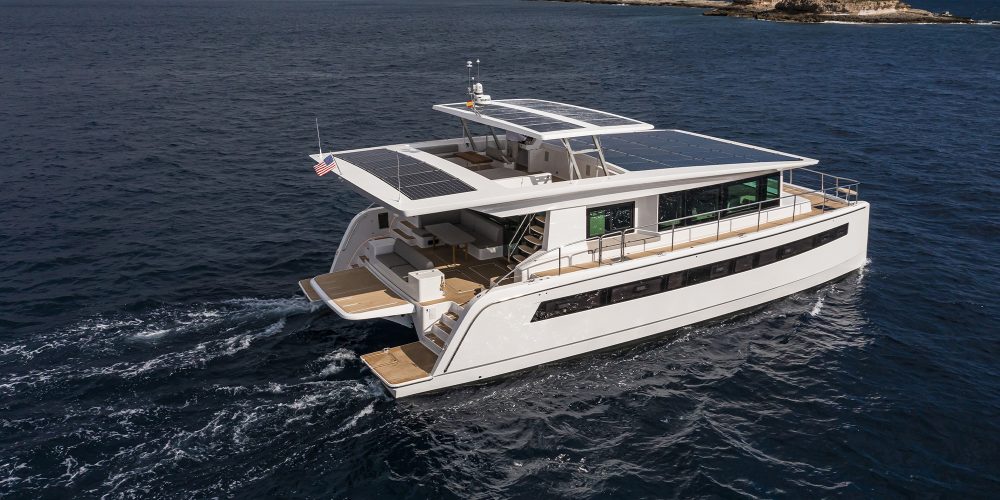

The SILENT-60 solar yacht specs
In addition to being a yacht completely powered using solar energy, Silent Yachts has now shared an additional kite wing option that can deliver even more clean range to the Silent-60.
According to the press release, the SILENT-60 will be the first vessel to be fitted with a nine or 13 square meter kite wing, although the option will now be available on all Silent Yacht models.
After deploying the compact kite, it drifts away on the surface of the water before pulling taught and launching into the air. When it reaches its optimal flight height, the kite begins to trace a “figure 8” in the sky, generating additional power to pull the solar yacht. Silent Yacht founder Michael Köhler elaborates:
The main advantages of a kite over a conventional sail system are that it does not throw shade on the solar panels, does not need a tall mast, and generates up to 10 times more power per square meter than a traditional sail. In addition to that it saves about 1.5 tons of weight compared to conventional rig and costs much less. It makes even more sense for the SILENT boats that run on renewable solar energy because the power generated by a kite easily exceeds the energy consumption of the system, so you can charge the batteries while cruising under kite power. And besides that, it’s great fun!
When yacht owners want to stop kiting, an automated app controls the kite, moving it to a position right above the boat where it has the least pull on the line. This allows for more easy electric winching down over the foredeck for stowage.

In addition to the wind kite option, the SILENT-60 yacht comes with 42 solar panels, garnering 17 kWp of energy from the sun to power two, 340 kW electric motors. The system is backed by a battery capacity up to 286 kWh.
As a required safety measure, the SILENT-60 is equipped with a generator and 1,000 liters of fuel. However, according to the Silent-Yachts’ owners, they almost never use it because they have enough solar power and electric energy.
According to Silent Yachts, the SILENT-60 can cruise efficiently with zero emissions using solar power only for up to 100 nautical miles a day and can maintain that pace for weeks. The vessel’s cruise speed is six to eight knots, but it can get up to a top speed of 20 knots using the all-electric motors.
The SILENT-60 comes with four guest cabins but can be designed with a custom layout for those willing to pay a bit more. Speaking of which, the SILENT-60 starts at 2.39 million euros ($2.69 million).
The first of these SILENT-60 solar yachts was built in Thailand, but the company plans to build future units in Italy. Furthermore, Silent Yachts has already shared design plans for a SILENT-80 and SILENT-100 Explorer vessel.
More electrified boats are sure to make their maiden voyage soon. In the meantime, check out this launch video detailing the style and luxury of the SILENT-60:
Electrek’s take
The more I see electric propulsion on larger and larger boats, the more excited I get. While this is still such a niche segment in not just maritime transportation, but electrified mobility overall, it really excites me personally.
Many of you (hopefully) saw my previous article where I got to captain a solar-powered yacht called the Ramblin’ Rose, thanks to Sunwater Marine . That experience helped me learn and experience a lot of similar technology that Silent Yachts has implemented on an even larger and more powerful scale with its catamarans.
While it’s safe to say that my current income level might get me on board a SILENT-60 solar yacht as a mere stowaway, those who can afford their own are going to be blessed with luxury and performance with zero emissions. The quicker we stop burning diesel in our Earth’s waters (and anywhere else while we’re at it), the better.
A top speed 20 knots is nearly 23 mph, not bad for two electric motors getting all their energy from the sun. Obviously, that speed is not sustainable for the batteries, but being able to get 100 NMs from the sun each day truly means you can take this yacht out for weeks at a time if you want. Not to mention the unique wing kite that actually pulls the 60-foot yacht, unlike a sailboat that is pushed by the wind. No range anxiety here.
I’d love to get below deck on one of the Silent Yachts and explore the inner workings… while getting a tan in the Mediterranean, perhaps? A kid could dream, right? For now, I’ll simply have to report electric boat news from my squeaky chair, pretending the cars whizzing by outside are calm ocean waves lapping against the yacht’s hull. Is it too early for a mojito?
FTC: We use income earning auto affiliate links. More.


Scooter Doll is a writer, designer and tech enthusiast born in Chicago and based on the West Coast. When he’s not offering the latest tech how tos or insights, he’s probably watching Chicago sports. Please send any tips or suggestions, or dog photos to him at [email protected]
- Yachting World
- Digital Edition

Review: Silent 55, the extraordinary solar powered yacht
- January 18, 2019
Silent Yachts is tapping into the solar zeitgeist and creating a new meaning for the term ‘powercat’. Sam Fortescue reports

There is a slow, silent revolution under way in the yachting world. It is a revolution that is introducing tonnes of lithium and a sprinkling of silicon to the spec list of new boats. Holding out the promise of silent mobility, plus limitless domestic power on board, it made a big splash at the last Cannes Festival of Yachting – not least thanks to the new Silent 55 catamaran which debuted there.
From the pontoon side, the Silent 55 looks like a typical modern catamaran, with a big coachroof studded with windows and a flybridge helm. Except there’s no mast. Now, bear with me here. I realise that this is a sailing magazine, but we will shortly get back to more familiar territory. The unique qualities of this catamaran only become apparent from up top, where an expanse of solar panels stretches away fore and aft, embedded into the coachroof. The hard top itself carries yet more panels, and can be folded down flush to give an unshaded solar array of 49m2. During the heat of a summer day in the Med, this is capable of generating 10kW of power and up to around 60kWh in the course of the day.

But to make a solar system work in reality, Köhler had to go back to the drawing board on yacht design. The saloon and hulls have extra thermal insulation to keep air-con losses down, and the use of carbon and aramid in key areas helps reduce the overall weight to a decent 17 tonnes (a Lagoon 52 weighs 22.5 tonnes). He has tried to keep windows out of the direct sun with long overhangs and in contrast to the Lagoon’s 12 deck hatches, the Silent 55 has just two.
Holistic design
On the other hand, it has lots of opening windows, to allow a natural draught to do its job. “It’s a holistic approach – you can’t take the batteries and the drivetrain and drop it into another boat.”
Of course, using the propulsion system quickly takes its toll of the boat’s 140kW battery bank. The model on display at Cannes had two 135kW motors, giving you just half an hour of silent motoring flat-out, albeit at a top speed of over 20 knots. More reasonable 30kW engines and a single-digit speed give you greater range. Nonetheless, the electric drive alone isn’t going to allow you to outrun a storm, or race home after a day at anchor, so the boat is designed to work with a generator hidden in the heavily insulated transom of its starboard hull. At cruising speed of around 5-6 knots, Köhler says there is rarely any need to use the generator, citing an owner who has just emailed him triumphantly about a second year totally generator-free. “In the end, you have to compare it to the performance of a sailing boat,” Köhler says. “It is as fast as a sailing boat in similar conditions – after all, there is no wind without sun.” He went so far as to tell me during the sea trial in Palma, Mallorca, that he believed the majority of sailors would happily dispense with the hassle of sails and a rig if only they could enjoy silent motoring and anchoring. “As soon as people realise the incredible concept of this boat, they won’t understand why they ever did anything else.”
The market does not seem to agree with him – yet. Sales of the boat have been good – they have already sold six, five of which are already in the water. But of those, four customers have taken the sail option, which means planting a 19.7m tall mast complete with boom and rigging slap bang in the middle of the coachroof solar array. “I was a bit amazed,” Köhler admits. “The shade from the rig reduces the energy generated by the solar area, while it costs more and is heavier, so consumes more fuel. Maybe it is for optical reasons.” In fact, the shade of the rig slashes the average yield of the solar panels in half. In the Med, that means around 30kWh per day. But perhaps it figures. The typical profile of buyers is an environmentalist who has a Tesla electric car and is “an early adopter who likes to have things before others”. And at low speeds, with modest use of the air-con, the reduced energy generation should still cover daily consumption.

The performance under sail should be reasonable because of the lightweight build of the boat, its broad 8.47m beam and stub keels added to each hull. Control lines are led back via conduits in the coachroof to the flybridge helm station, to make single-handing under sail a possibility.
More interesting, I think, is a sort of halfway-house option using a kite rig. This optimises the performance of the solar panels and gives plenty of propulsion. On the smaller 55 and the 64, Silent Yachts currently recommends a 19m2 kite that costs around €25,000 – a fraction of the cost of a new mast, boom, shrouds and sails. “The sail automatically makes a figure of eight above the boat, and you can steer it with a joystick or an app on an android phone,” Köhler explains. “It can propel the 55 at up to 6 knots, even in light winds.” Perfect for an Atlantic crossing, then.
For the bigger Silent 79, which will hit the water in the summer, a commercial grade Sky Sail system needs to be used – a smaller version of the ones used on cargo ships. This kite can propel the boat at ten knots, but it costs more than ten times as much as its smaller cousin. Both are capable of pulling the boat upwind. So far, so new. But outside the novel energy and propulsion system, the Silent 55 aims to do what many other cruising catamarans are trying to achieve. “Most of our clients order for circumnavigation and long-term cruising,” Köhler says. So the boat is aimed to be as comfortable and capable as possible with watermakers, TVs and an induction hob that all capitalise on the boat’s abundant energy. A flexible configuration allows owners the choice of between three and six cabins – the latter designed for charter. The owner’s cabin lies forward of the saloon, under the windows of the coachroof, which provide magnificent views and abundant natural light. There’s a walk-around bed and steps down into the starboard hull give access to an en-suite shower room and heads.

In my view, the best cabin lies aft of this, accessed in the traditional manner down steps out of the saloon. The king-sized bed lies athwartships and the shower is larger than that of the master cabin. There’s more space down here, better headroom and still plenty of light courtesy of the many hull lights.

When I had the chance to sea trial the Silent 55, albeit in motorboat format, I jumped at it. It was a contrary autumn day on Mallorca with 15 knots breeze – just a shame, then, that this wasn’t one of the sailing configured versions.
To start with, getting on board is made really easy courtesy of deep boarding platforms on the skirts. She feels rather square because of that vast, glazed saloon with its deep overhang, and perhaps because of the utilitarian nature of the hard top, which is really about supporting more solar panels. Nevertheless, the side decks are broad and uncluttered. The space up top is designed to concertina down flat, hence the hydraulic rams, fold-down seat back and lowering console. It makes a great sailing position, though, with all round visibility, and is also perfect for sundowners at anchor. When the rain comes down, this feels quite exposed, but there is a fully sheltered helm at the front of the saloon, and it is also possible to drive the boat from anywhere using a tablet thanks to smart electronics. Under power, the handling is superb. The quietness of the motors is astonishing, and I gather they’ll be inaudible on the next boat, which will do away with the gearbox. Even in the aft cabins, directly above the motors, there is no more than a distant hum. The boat responds instantly to the power and the wind seemed to have no impact at all. As with any propulsion system, the power consumption jumps as you pile on the speed – it was sobering to see. At 6 knots, both motors drew 10kW but at 8 knots it was closer to 30kW. I liked the huge saloon with its raised table for 360º views. And the sliding door and window gives great access aft, connecting the saloon and cockpit in fine conditions. The finish was smart and in muted tones, feeling more Scandinavian than German.
Intriguingly, at least it seems to me, Köhler has tapped into something with the concept behind Silent Yachts – but not entirely for the reasons that he expected. Buyers are opting for the sail or kite versions of the boat because they want a comfortable wind-powered craft with abundant, quiet energy on tap. It brings a whole new meaning to the term ‘powercat’

Multihulls: new yacht reviews
Yes, the racing world is stretching the boundaries, with 100ft foiling maxi trimarans tearing around the globe and F50s, the…

Multihulls: owners’ experiences and reviews
They have two different boats, different sailing plans and two very different sets of experience. But what these cruisers have…
- Motorcycles
- Car of the Month
- Destinations
- Men’s Fashion
- Watch Collector
- Art & Collectibles
- Vacation Homes
- Celebrity Homes
- New Construction
- Home Design
- Electronics
- Fine Dining
- Aston Martin
- Costa Palmas
- L’Atelier
- Les Marquables de Martell
- Reynolds Lake Oconee
- Scott Dunn Travel
- Wilson Audio
- 672 Wine Club
- Sports & Leisure
- Health & Wellness
- Best of the Best
- The Ultimate Gift Guide
Boat of the Week: This Solar-Powered Electric Catamaran Can Cruise Silently and Emissions Free
Minimal emissions from a solar-powered, 60-foot motoryacht is a very big deal. but we found other big features that could be improved., howard walker, howard walker's most recent stories.
- This 112-Foot Superyacht Has an Interior That’ll Make Your Manhattan Condo Jealous
- This 1967 Shelby GT500 Has Been Reimagined to Perfection. Now It’s up for Grabs.
- One of Ferrari’s Earliest Formula 1 Cars Is Now Up for Grabs
- Share This Article

John, Paul, George and Ringo singing “Here Comes the Sun” would make the perfect anthem for Austrian-owned Silent Group’s newest 60-foot power catamaran, the $3 million Silent 60.
Why? Without sunshine, you won’t get very far.
Thankfully, the searing Florida sun is beating down as we take to Fort Lauderdale’s bustling Intracoastal Waterway to try-out this eco-friendly Silent 60. With its roof and foredeck crammed full of solar panels, the sixty-footer is humming along at a leisurely six mph on just zero-emissions battery power.
Related Stories
- Tesla Is Putting Elon Musk’s $47 Billion Pay Package up to a New Vote
- Lotus’s New Electric SUV Is Coming This Year
- Superyacht Sales Down 17 Percent Last Year

The batteries are recharged by solar panels that occupy nearly every available square foot of exterior space. Courtesy Silent Yachts
Just as its name suggests, the ride is hushed, with just the gentle, soothing sound of water bubbling-up in the wake to interrupt the peace and quiet.
“Silent running is top of the list when it comes to what appeals to our customers. They don’t want to hear engines or feel vibration,” Silent Yachts ‘ in-house designer Juliana Miguel told Robb Report , during the run.
“These days it’s also about fuel costs,” adds US sales director, Philip Bell. “One customer ordered a new 60 after getting tired of using his 80-foot Italian motoryacht for weekend trips to the Bahamas and spending $12,000 on fuel each time.”

The 30-foot beam delivers strong interior space and wide social areas on the outside. Courtesy Silent Yachts
The Silent 60’s claim to fame? Quiet, zero-emission, electric-only cruising at 7 to 8 mph for up to nine hours, or roughly 100 nautical miles a day. Throttle back to 4 mph, and the company says you have the possibility of near perpetual motion.
We’re sampling the third hull of the constantly evolving Silent 60 series that launched last summer. Silent has been the leader in inventing the solar-powered electric-cruiser niche. Replacing the original Silent 55, the 60 has been such a boat-show hit that more than 30 are currently awaiting construction at Silent’s yards in Fano, Italy and Istanbul, Turkey.
The yacht we’re on is an original folding-hardtop version, with its cantilevered roof panel that, at the push of a button, lowers to cover the small, open flybridge area. Tastes, however, are evolving.

The boat’s 30-foot beam allows for an apartment-sized, open salon. Courtesy Quin Bassett
According to Bell, most of the new 60s currently in build are “tri-deck” models, featuring a significantly larger flybridge area, a fixed rather than folding roof (also covered with solar panels), and the option of a fully open flybridge, or glass-enclosed “sky lounge,” designed for additional entertaining space or even a master suite.
At the dock, given its 30-foot beam, the 60 looks humongous. To our eyes, it’s not going to win any beauty contests. Towering, vertical hull-sides, a fairly-shapeless upright bow design, and straight up-and-down cabin sides give the catamaran a square-edged, boxy look. All function with little form.
But what the owner gets are huge interior spaces. Inside, it feels like a floating apartment, with a cavernous salon, spacious galley, large dining area, and huge aft deck. Down below are choices of three or four spacious en-suite cabins in the hulls.

A good boat for the sunny canals of Fort Lauderdale. Courtesy Quin Bissett/Silent Yachts
But the quality of the interior doesn’t track with the boat’s $3 million-plus price tag. Thin cabinet doors, dull-looking fabrics, gelcoat fiberglass on the salon ceilings, faux-wood vinyl flooring, and an inside helm station that was little more than an upholstered board with instruments that looked haphazardly arranged, were all below par, considering the upscale market Silent is targeting.
Miguel says the interior will change with the next generation of 60s arriving towards the end of the year, with a big step-up in terms of quality of materials, attention to detail, style, and fit and finish. So, why didn’t they wait to unveil the boat to the media before they got to that point?
The man at the helm is Silent Yachts’ delivery captain and chief tester Kyle Miller. With a jiggle of a joystick control and a touch of bow-thruster, he maneuvers the 60 out of its tight, side-on slip and eases into the busy Intracoastal Waterway.

All function, no form? The 60-footer’s boxy shape is out of synch with other cat manufacturers that use more curves in their superstructures. Courtesy Silent Yachts
The yacht features Silent’s E-Power propulsion package, with twin Dana TM4 200kW or 268 hp electric motors and 207kWh lithium-ion batteries. They’re good for an 8 mph cruise speed and claimed 16 mph top speed. There’s also a base version with twin 50kW or 67 hp motors juiced by a 143kWh lithium-ion battery bank. Even Miller admits this is short on power.
The best, and of course the priciest, option is the E-Power+ package, featuring twin 340kW 455 hp motors and 286kWh batteries. It’s said to be good for tide-punching bursts of up to 20 mph.
“For anyone who wants to dash around at 17 knots all day long, our recommendation is to buy a different boat,” says Miller. “The Silent 60 is designed for relaxing on the move, gliding from one anchorage to the next, and being self-sufficient on the hook.”

Open space on the flybridge. Courtesy Silent Yachts
As we discovered, the 60 isn’t always a Tesla of the seas. Running over 6 mph will necessitate firing up the Hyundai diesel generator for one of every three hours of running time to keep the batteries charged. And that’s not silent.
While ambling along at 6 mph is fine for laid-back cruising, we also had concerns about a lack of reserve power for tackling strong currents and adverse tides.
Even our test boat’s twin 200kW motors struggled to keep the 60 under control when maneuvering against a fast, incoming tide under Lauderdale’s narrow 17th Street Bridge. The bigger 340kW motors are definitely the way to go for running in fast currents or tidal waters.

Galley and dining area Courtesy Silent Yachts
Without doubt, this new Silent 60 showcases the appeal of electric power on the water. The way it efficiently and effectively harnesses the sun’s rays, its largely zero-emissions running, coupled with its huge and versatile interior space, is impressive for a family cruiser.
Just don’t plan on getting anywhere in a hurry—and beware of fast-running tides.
Read More On:
- Electric Yacht
- Silent Yachts
More Marine

How Design-Savvy Electric Boats Are Shaping the Future of Yachting

This New 197-Foot Explorer Yacht Has a Plush Cigar Lounge That Doubles as an Office

Maserati Just Unveiled a New All-Electric Powerboat to Match the Folgore EV

This Sporty New 140-Foot Superyacht Rocks the Same Metallic Paint as Your Supercar

Culinary Masters 2024
MAY 17 - 19 Join us for extraordinary meals from the nation’s brightest culinary minds.
Give the Gift of Luxury
Latest Galleries in Marine

Project Supernova in Photos

Meet ‘Sarastar,’ the 197-Foot Superyacht With the Wildest Interior on the High Seas
More from our brands, rihanna does full-body fenty x puma creeper phatty ‘earth tone’ colors at launch party, aaron judge’s big toe trouble stubs yankees’ hot start, odds of u.s. tiktok ban increase after house fast-tracks revised bill, picking up key senate support, alex katz’s new paintings in venice celebrate grass, water, and clothes, the best yoga mats for any practice, according to instructors.
the new SILENT 60 electric catamaran features a kite wing and 42 solar panels
Zero emission cruising at 20 knots.
SILENT-YACHTS unveils the new SILENT 60, a solar-powered catamaran with a kite wing instead of conventional sails. 42 solar panels generate 17 kWp to power two electric motors of 200 kW each. the 60ft (18m) yacht is also backed up by a battery capacity of 286 kWh, allowing zero emission cruising for up to 100 nautical miles per day.
THE KITE WING
the kite wing and its components—including an electric winch and a short, collapsible mast—are stored in a locker under the foredeck. on the first SILENT 60 unit, the mast is connected by four shrouds to pad eyes on deck that distributes the forces through the hull structure, but on subsequent units, the mast will be mounted on a baseplate inside the locker to leave the foredeck clutter-free.
after inflating the kite, it is released overboard to drift away on the surface of the water. pulling on the lines launches it into the air and once it reaches the optimal flight height, it begins to trace a figure ‘8’ in the sky and generate power to pull the yacht. reversing the process brings the kite down. the automated app controls move the kite to a position right above the boat where it has the least pull on the line. from here it can easily be winched down and collapsed over the foredeck ready for stowage. the kite wing is now available on all SILENT-YACHTS models.
flexible layout
the first SILENT 60 has four guest cabins on the lower deck, including a spacious master suite, but other layout solutions are available. there are numerous social areas onboard, including an airy main salon, an aft cockpit, a cozy bow area and a flybridge. the yacht also has high headroom throughout (up to 2.3m in the main salon).
thanks to a draft of under 1m the yacht can access shallow bays, a crucial consideration for cruising grounds in the caribbean and south east asia. two swimming platforms in the stern can be extended on the owner’s request to carry a pair of electric jet skis. the lifting hydraulic platform between the two platforms can also be enlarged to carry a 4m tender.
efficient technology & OCEANIC RANGE
the SILENT 60 is equipped with the company ’s aeration system, which provides cool and fresh air to all the interior guest spaces and can be individually adjusted to suit conditions. in addition, a reverse-cycle heat-pump system heats the interior for all-season comfort. the insulated hull ensures that stable onboard temperatures can be achieved without excessive energy consumption.
a watermaker powered by the solar-electric system produces enough water to supply a full complement of guests. all on-board appliances operate on the 220/110-volt system. the galley has good refrigerator and freezer space and an efficient induction cooker that precludes the need for carrying propane gas.
the SILENT 60 is designed to go everywhere as a true bluewater cruising yacht. the solar-electric system is configured to power all on the onboard systems without the need of a fossil-fueled generator. featuring a new, high-performance hull form with a longer waterline and reverse bow, the yacht has a cruising speed of 6-8 knots, but can reach 20 knots if needed.
project info:
name: SILENT 60 company: SILENT-YACHTS
designboom has received this project from our DIY submissions feature, where we welcome our readers to submit their own work for publication. see more project submissions from our readers here.
edited by: lynne myers | designboom
DBINSTAGRAM (2250)
Solar power (369).
mobile solar container stores photovoltaic panels that fold and unfold like an accordion
WATERCRAFT (75)
Yacht design (228), product library.
a diverse digital database that acts as a valuable guide in gaining insight and information about a product directly from the manufacturer, and serves as a rich reference point in developing a project or scheme.
- car design (793)
- electric automobiles (638)
- materials (67)
- recycling (327)
- car concept (357)
- space travel design (96)
- sculpture (353)
- turntable design (27)
designboom will always be there for you
- THE PRINCESS PASSPORT
- Email Newsletter
- Yacht Walkthroughs
- Destinations
- Electronics
- Boating Safety

Silent Yachts 55 is the Quiet Powercat
- By Phil Draper
- Updated: April 16, 2019
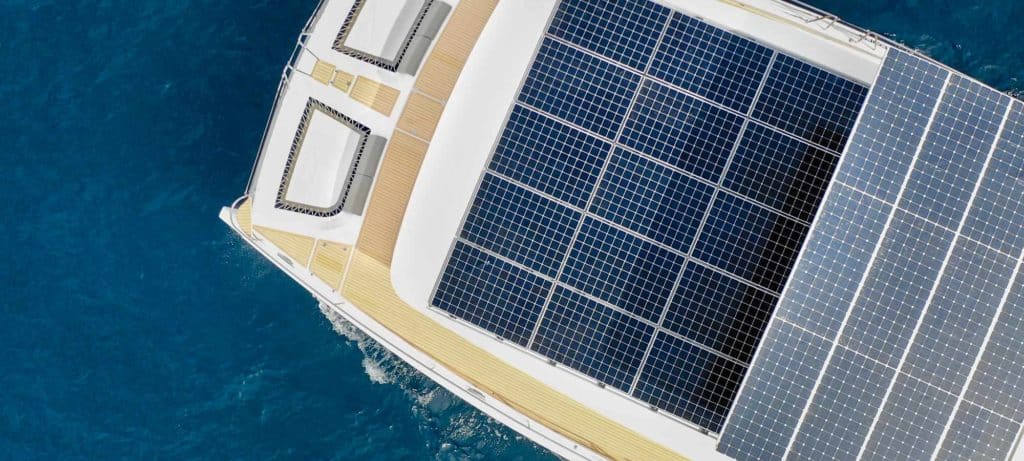
For a quiet yacht, the first Silent-Yachts 55 power catamaran has made a lot of noise. It is the world’s first mainstream yacht with a fully functioning solar installation as standard power.
And it works: When I got aboard a 55 in Spain’s Balearic Isles, it had been cruising for a month without any need for a port or marina services. My arrival was an excuse for the skipper to top off the tanks and fire up the generator for the first time in days.
The yacht comes in three versions: Cruiser (which is what I got aboard), E-Power and Hybrid. Cruiser is solar-focused. E-Power ups the capability of the e-motors as well as the batteries, while Hybrid has twin diesels and electric motors to offer 20-knot speed.
In all the power configurations, solar panels cover most of the Silent 55 ‘s upper surfaces. There are 32 panels in all, comprising a 527-square-foot, 10 kW array.
Beneath those solar panels is a thoroughly modern cruiser with a variable-speed 100 kW Volvo Penta D3-220 generator, a 140 kWh lithium-ion battery bank from MG Energy, Brusa chargers and inverters, and twin brushless 135 kW UQM electric motors whisking straight shafts and four-blade, fixed-pitch props. A control system integrates everything in an easy-to-use format.
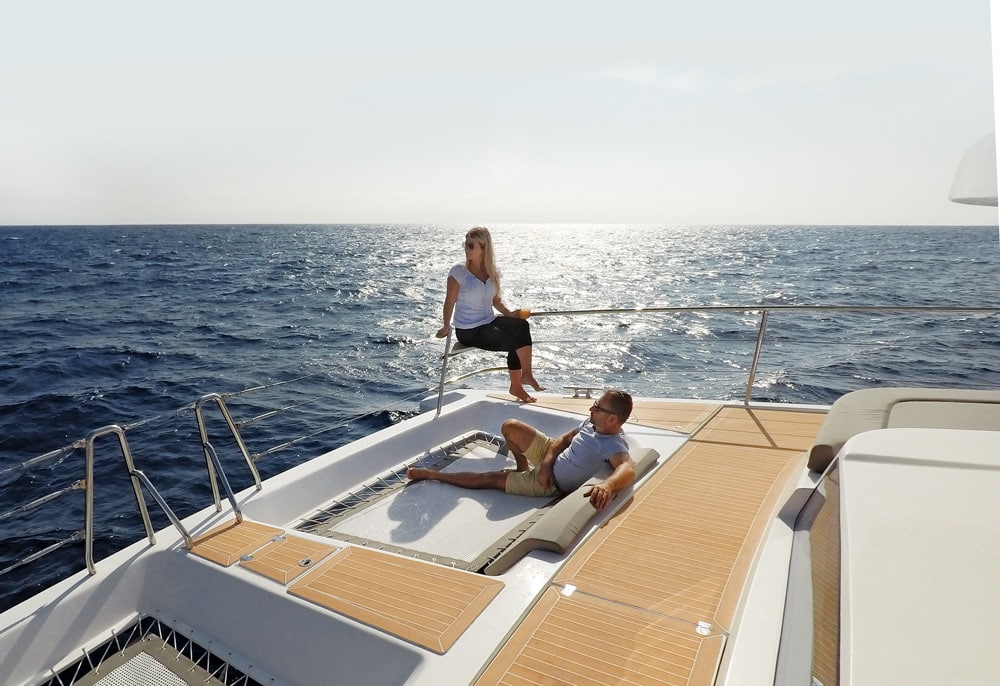
“This solar-power installation works properly because we have taken a holistic approach,” says company founder Michael Kohler, an Austrian lawyer and yachtsman with several transatlantic crossings and tens of thousands of sea miles under his belt. He developed the solar concept with Hamburg, Germany-based iYacht.
“You can’t start with a conventional design and install unconventional systems,” he says. “That would not work. Almost every aspect of this model’s specification has been considered from an energy-efficiency perspective.”
Solar-powered boats are destined to function almost exclusively in sunny-weather zones, meaning there will be high demands on air conditioning systems. So the Silent 55’s hulls are insulated, resulting in less unwanted heat entering the boat and less cold air escaping. All of the hull and superstructure glazing limits greenhouse effects with shading and angled glass, to reduce ultraviolet radiation.
Similarly, there are just two deck hatches aboard the Silent 55, whereas a conventional cat of this size may have a dozen. The conventional yacht would probably require 80,000 to 100,000 Btu of air conditioning in the Caribbean or Mediterranean, whereas the Silent 55 has a 50,000 Btu system, drawing less power.
Interestingly, the hotter the solar panels get, the less efficient they become. Ventilation has to be effective above and below the photovoltaic cells. The panels aboard the Silent 55 convert around 22 percent of the total energy received into electricity. Ten years ago, the best panels converted about 14 percent.
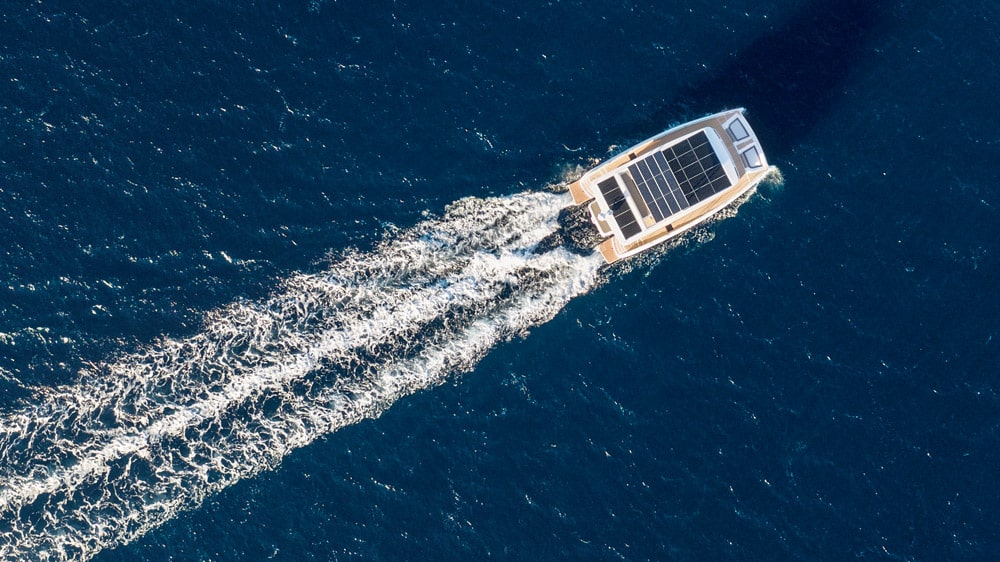
During a typical summer day in the Med, Kohler says, the Silent 55 can produce 50 to 60 kWh with 10 kW power-generation peaks. Putting that into perspective, normal energy demands would be around 10 kWh. With energy-efficient appliances and systems installed, the yacht should support four to six people’s worth of cooking, refrigeration, lighting, hot water and air conditioning.
Cruising ranges depend on load and power-generation variables. At around 5 knots, the 55 could cruise for 20 to 25 nautical miles with the A/C working. The top speed is probably around 14 knots, but for less than an hour. The Silent 55 that I got aboard in Spain had just completed a 70-nautical-mile passage between the closest bays of Mallorca and Ibiza. The passage took about 12 hours using only solar generation and stored battery power, at an average speed of 5.8 knots, Kohler said. Her diesel generator was not used at all, although on arrival, her batteries were almost empty.
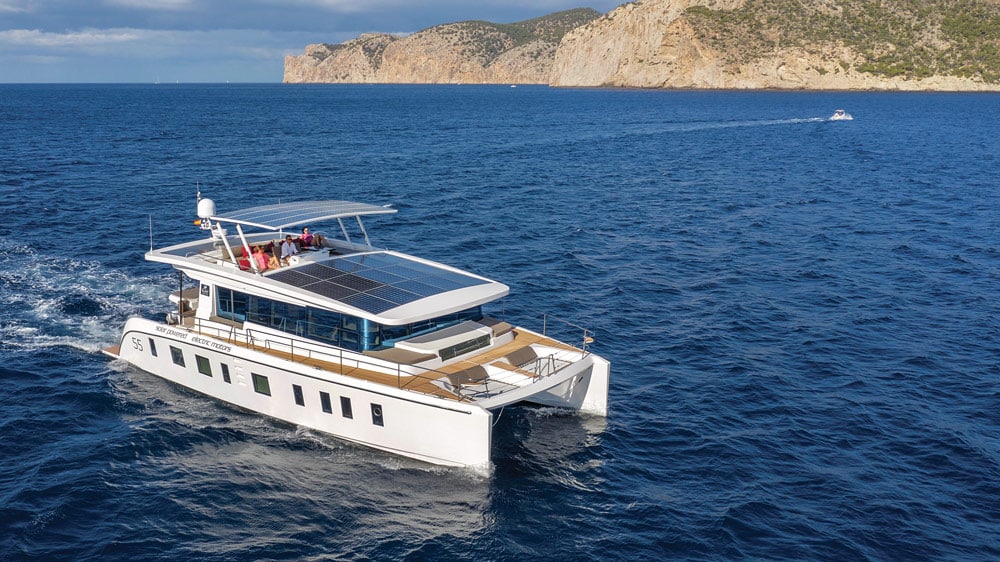
At an average 4-knot pace with the watermaker aboard, she’s virtually self-sustaining, Kohler says. She has the potential to achieve 100-nautical-mile days. With generator help at around 7 knots, she should manage 360 nautical miles before refilling her diesel tanks, which hold 159 gallons total. The generator kicks in automatically when battery levels fall below preset parameters, and switches off when a sufficient charge returns. During my test cruise between Puerto Portals and Santa Ponsa, which is about a dozen miles, the limits were set at 30 percent and 70 percent, respectively, and the generator hadn’t been run for at least three days, during which she had covered a relaxed 40 to 45 nautical miles around Mallorca’s coast. And she didn’t need to run the generator overnight with the A/C on.
Beyond her power setups and capabilities, the Silent 55’s outdoor areas deliver the usual walk-around features of a catamaran: side decks, a foredeck with trampoline loungers, and a full-beam aft deck, whose setup is open to client interpretation. The 55 that I was aboard had a dining table, double sofas and a raised a sun pad that could be replaced by an optional hydraulic tender platform.
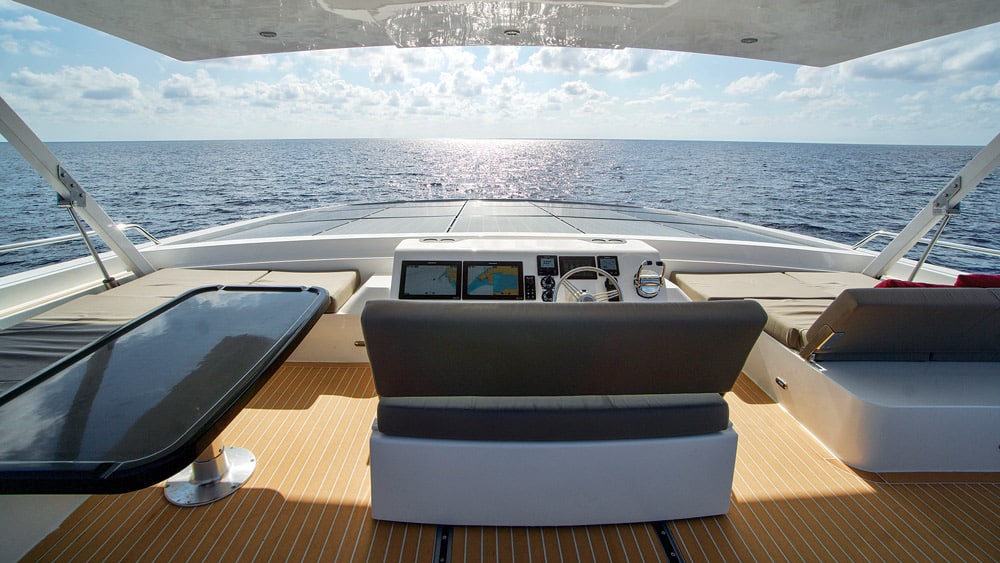
The deckhouse includes a galley aft, an amidships sofa and table to port, and a helm station to starboard. The forward owner’s stateroom is wide with well-shaded wraparound windows and portlights at varying heights. There are three other guest staterooms, all en suite with the same matte oak veneers.
The Silent-Yachts 55 creates relatively green cruising with notable range for a solar-powered craft. Though she runs quiet, her mission rings out loud and clear.
Silent 79 The next model from Silent-Yachts will be the Silent 79. While the company developed the Silent 55 and 64 models with iYacht in Germany, the Silent 79 is the work of Marco Casali in Italy and Enrique Castilla’s Inseval studio. Lamination of the first 79 is expected to commence this year.
Sails Be Gone The first four Silent 55s, delivered in 2016, were sailboats with masts and booms towering above the solar panels. The first true power catamaran is new, and the founder of Silent-Yachts says the design improves on efficiency; the shade from sails significantly impairs the efficiency of the solar panels.
Take the next step: silent-yachts.com
- More: Power Catamarans , Silent-Yachts , Yacht Reviews , Yachts
- More Yachts

wallywhy150 Reviewed

Boat Propeller Repair

Five Top Yachts For 2024

Riviera 585 SUV Reviewed

For Sale: Sirena Yachts 64
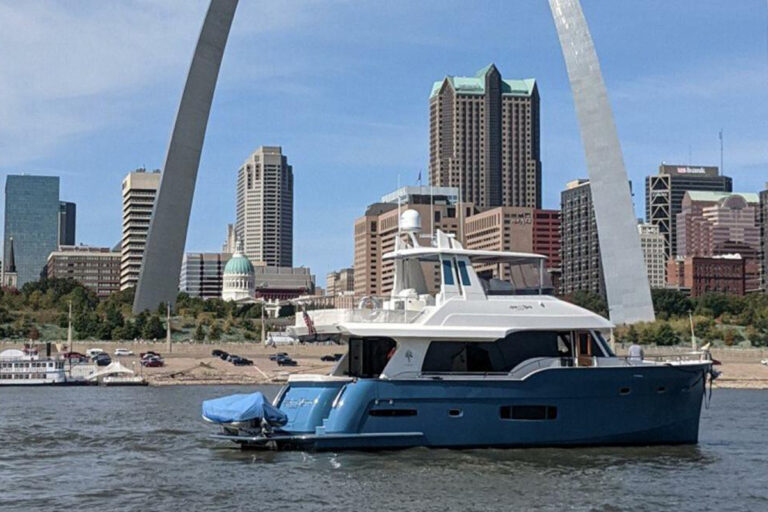
Outer Reef Yachts 620 Trident For Sale
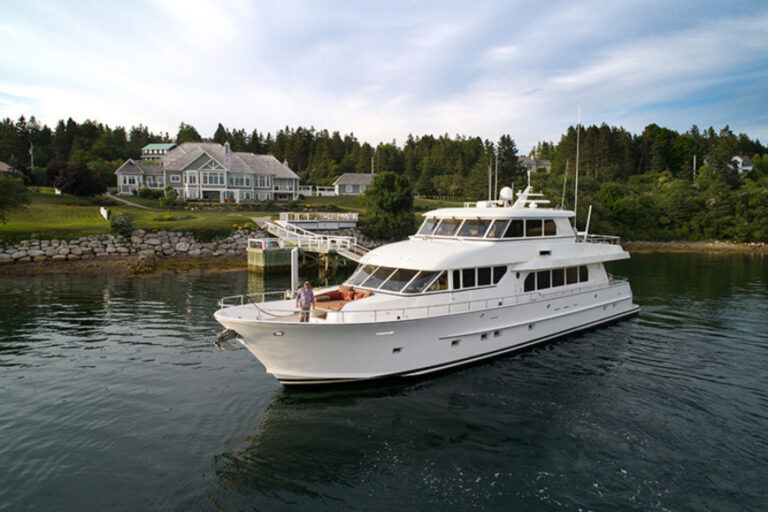
For Sale: Paragon 94
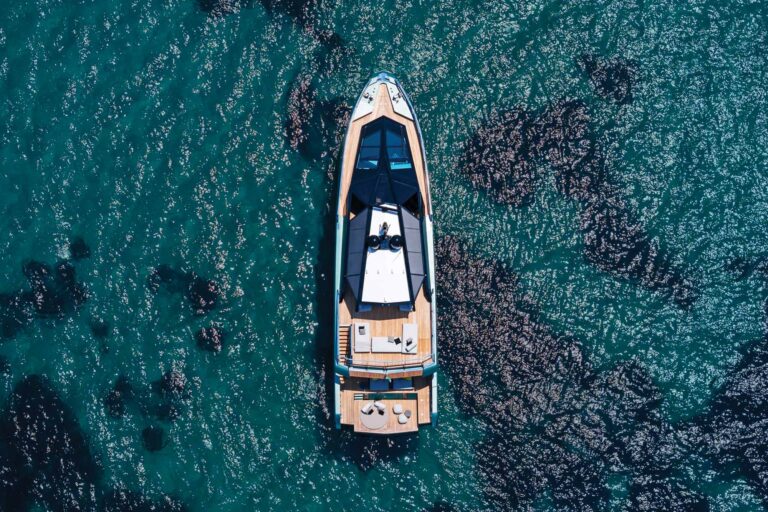
- Digital Edition
- Customer Service
- Privacy Policy
- Email Newsletters
- Cruising World
- Sailing World
- Salt Water Sportsman
- Sport Fishing
- Wakeboarding
You are using an outdated browser. Please upgrade your browser or activate Google Chrome Frame to improve your experience.
- Commercial & industrial PV
- Grids & integration
- Residential PV
- Utility scale PV
- Energy storage
- Balance of systems
- Modules & upstream manufacturing
- Opinion & analysis
- Opinion & analysis guidelines
- Press Releases
- Technology and R&D
- Sustainability
- 50 States of Solar
- pv magazine UP initiative
- pv magazine Hydrogen Hub
- Magazine features
- US module maker directory
- pv magazine Roundtables & Insights
- pv magazine Webinars
- Event calendar
- Past events
- Special Edition Las Vegas 2023
- OMCO Solar white paper
- Print archive
- pv magazine test
- pv magazine team
- Newsletter subscription
- Magazine subscription
- Community standards
Three-decker, solar and battery powered yacht hits the water in Italy
Silent Yachts launched the first Silent 62 3-Deck yacht, outfitted with 17 kWp of SunPower X400+ rigid glass solar modules and a newly enhanced 350 kWh LiFePO4 battery storage system, propelled by dual 340 kW electric motors.
- Energy Storage
- Markets & Policy
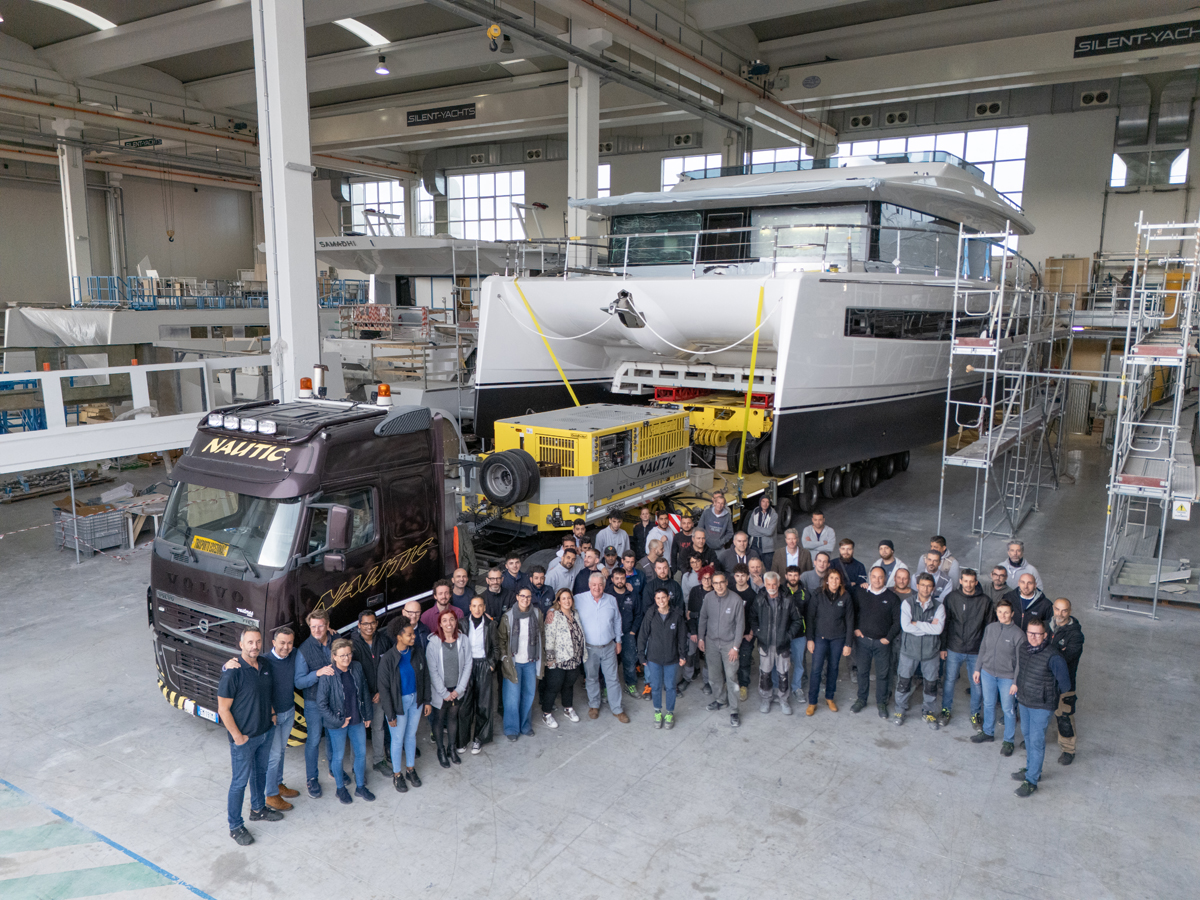
Image: Silent Yachts
Silent Yachts has launched the first three-decker redesign of its Silent 62 solar electric catamaran. The Silent 62 3-Deck features three separate solar module arrays totaling 17 kWp, an integrated energy storage system recently upgraded from 286 kWh to 350 kWh. Introduced in 2019, the Silent 60 series builds on the legacy of the Silent 64, which made headlines in 2018 as the first solar-powered yacht to successfully cross the Atlantic. The ship cruises at 6 to 8 knots and can reach peak speeds of 16 to 18 knots.
Owned by Austrian business leaders and based in Fano, Italy, Silent Yachts has recently expanded into a new production facility. This facility spans over 230,000 square feet and includes five buildings equipped for shipbuilding, two of which are topped with solar modules. The company celebrated the launch of its first boat from this new facility in February 2023.
pv magazine USA spoke with owners Michael Köhler & Mick Long about some of the finer details of their craft.
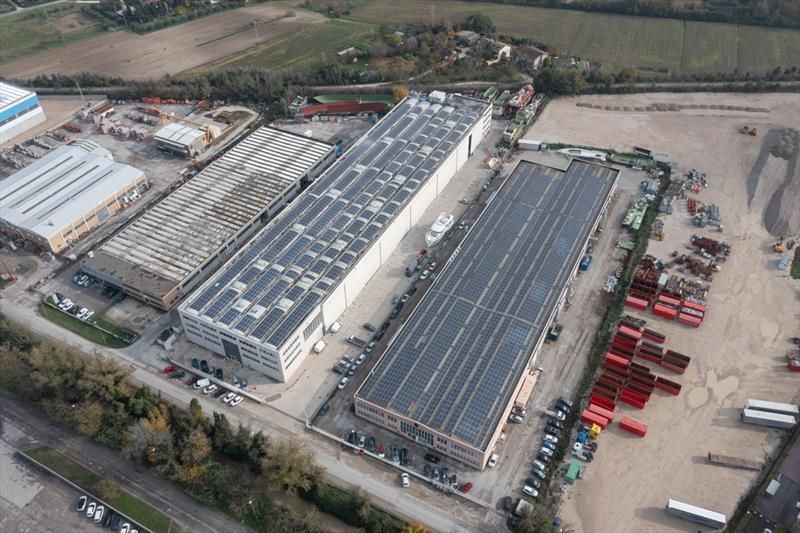
The Silent 62 3-Deck yacht’s highlight is its configurable third deck, which comes in three configurations: an open ‘sky lounge,’ a closed sky lounge, or a closed owner’s suite. The new model featured an open sky lounge, complete with a bar, galley and a 12-seat dining table. This yacht is outfitted with 42 SunPower X400+ modules totaling 16.8 kWp, backed by a 40-year warranty. Where the Flybridge model incorporates lightweight Solbian Maxeon3 panels on its retractable roof to reduce weight, the roofs of the 3-Deck versions are equipped with SunPower glass panels. Models ordered this year will include marginally higher wattage, pushing the total potential production up over 17 kWp.
The CEO of Silent Yachts, Michael Köhler, confirmed the use of these panels, along with a robust 350 kWh lithium iron phosphate (LiFePO4) battery pack. This pack features a quiet liquid-cooling system that enhances charging rates and extends the lifecycle to up to 3,500 recharge cycles. Propulsion is provided by dual 340 kW electric motors. The system operates primarily at 24VDC for navigation, lighting, and pumps, with household appliances at 230VAC and high-power systems like motors and thrusters at 800VDC.
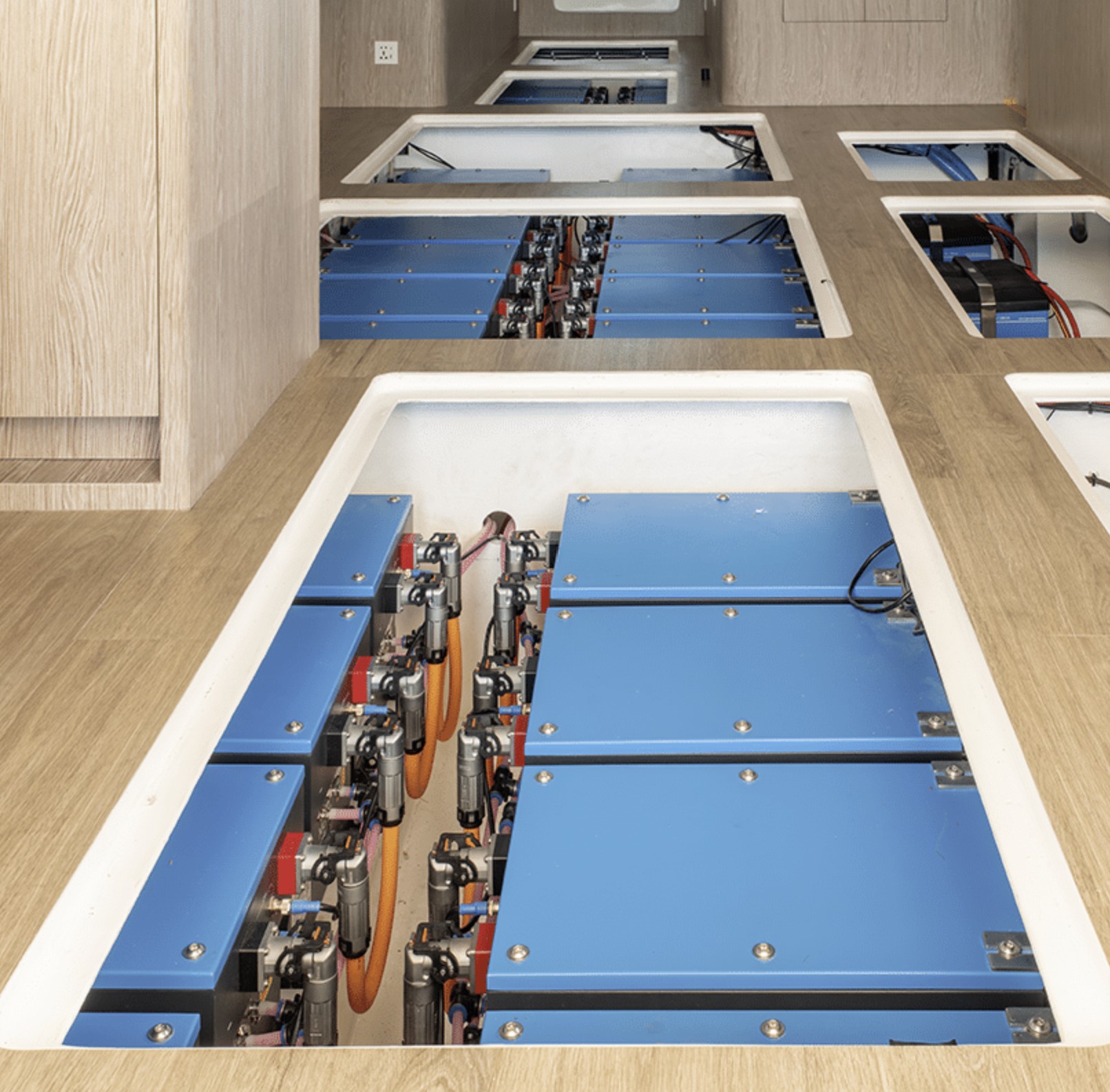
The Silent 62 yacht is equipped with advanced desalination equipment capable of producing up to 3,600 liters of fresh water per day. This system is efficient, consuming about 4 kWh to produce 1,000 liters of water, which aligns closely with the daily output of approximately one or two of the yacht’s solar panels. This integration ensures that water production is sustainable and minimally impacts the yacht’s overall energy reserves, making it ideal for extended voyages where freshwater is crucial.
A Youtube channel “Heart of Gold Lifeboat” provided a review of an earlier variant of the Silent 60, detailing the specifications and orientation of the electrical equipment and powertrain. The newer Silent 62 3-Deck has been updated with RS230 AH batteries, each offering 11.8 kWh, arranged in a 28-unit configuration. This model also features a proprietary power management system, which replaces the previously used Victron Energy Quattro combined inverter/charger. Additionally, the Volvo Penta D3 220 generator has been upgraded to a Hyundai S270 semi-commercial engine.
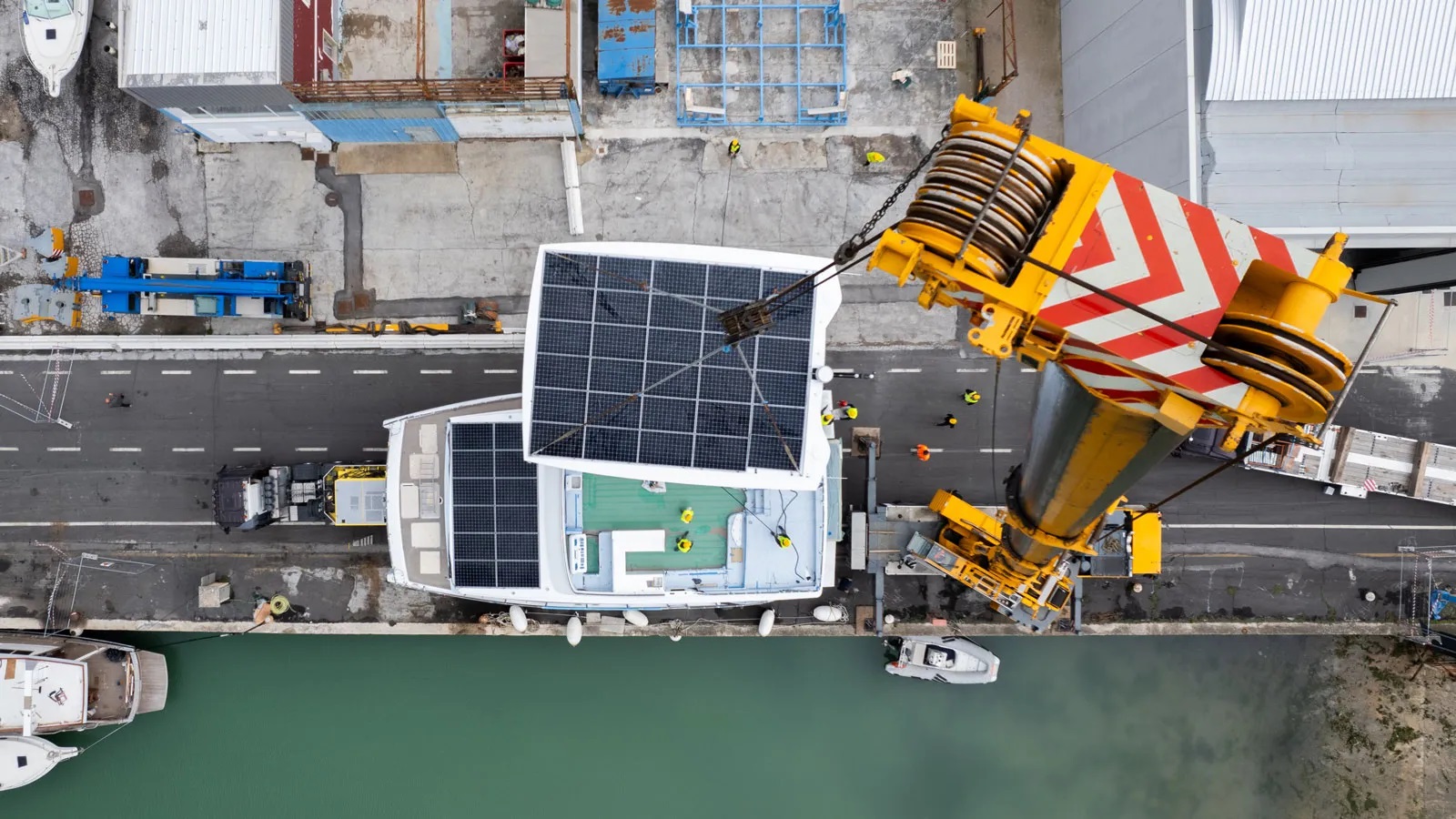
Accommodating up to 12 guests in its five cabins, the Silent 62 3-Deck is priced starting just over $2 million.
This content is protected by copyright and may not be reused. If you want to cooperate with us and would like to reuse some of our content, please contact: editors@pv-magazine.com .
John Fitzgerald Weaver

More articles from John Fitzgerald Weaver
Sunrise brief: Bifacial panels, representing 98% of U.S. solar imports, may soon be subject to tariffs
Related content, elsewhere on pv magazine..., leave a reply cancel reply.
Please be mindful of our community standards .
Your email address will not be published. Required fields are marked *
Save my name, email, and website in this browser for the next time I comment.
Notify me of follow-up comments by email.
Notify me of new posts by email.
By submitting this form you agree to pv magazine using your data for the purposes of publishing your comment.
Your personal data will only be disclosed or otherwise transmitted to third parties for the purposes of spam filtering or if this is necessary for technical maintenance of the website. Any other transfer to third parties will not take place unless this is justified on the basis of applicable data protection regulations or if pv magazine is legally obliged to do so.
You may revoke this consent at any time with effect for the future, in which case your personal data will be deleted immediately. Otherwise, your data will be deleted if pv magazine has processed your request or the purpose of data storage is fulfilled.
Further information on data privacy can be found in our Data Protection Policy .
pv magazine USA offers daily updates of the latest photovoltaics news. We also offer comprehensive global coverage of the most important solar markets worldwide. Select one or more editions for targeted, up to date information delivered straight to your inbox.
- Select Edition(s) * Hold Ctrl or Cmd to select multiple editions. Tap to select multiple editions. U.S. (English, daily) Global (English, daily) Germany (German, daily) Australia (English, daily) China (Chinese, weekly) India (English, daily) Latin America (Spanish, daily) Brazil (Portuguese, daily) Mexico (Spanish, daily) Spain (Spanish, daily) France (French, daily) Italy (Italian, daily)
- Read our Data Protection Policy .
Subscribe to our global magazine

Most popular

Keep up to date
Welcome to pv magazine USA. This site uses cookies. Read our policy. ×
The cookie settings on this website are set to "allow cookies" to give you the best browsing experience possible. If you continue to use this website without changing your cookie settings or you click "Accept" below then you are consenting to this.


SILENT Yachts
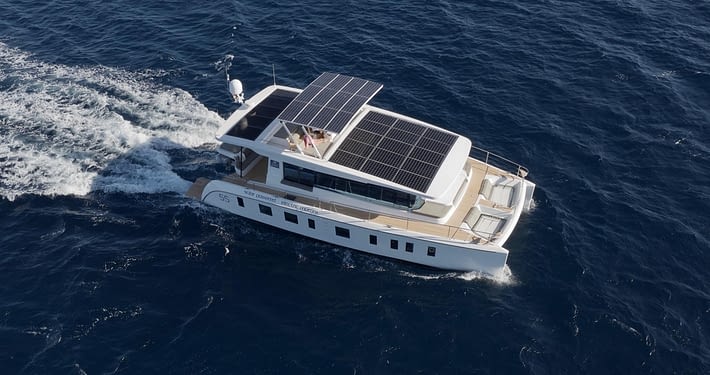
SILENT 55 – The award-winning solar yacht
In November 2019 the SILENT 55 won the “Best of Boats Award” in the “Best for Travel” category.
This special category is defined as “suitable for long-distance travel with all the amenities to live permanently on board, adapted to both inland waters and the harsh conditions at sea”.
In general, it can be handled easily by two people, which makes the SILENT 55 ideal for families who travel with or without additional crew.
General information
Trans-Ocean
Technical information
Displacement (ec).
500 – 1.000 L
Dirty water
600 – 1.600 L
Solar panels
Ce certification, sunlight yachts, office mallorca.
E-Mail-Adresse*
Ihre Nachricht (optional)
Email address*
Your message (optional)
Correo electrónico*
Tu mensaje (opcional)
Deine Fragen (optional)
Anfrage Bootsschule
Welcher Kurs interessiert dich? SBF Normal SBF Speed SBF Frauen SBF 2 Tage Privat SKS SRC
Gewünschter Kursbeginn ab:
Deine Nachricht (optional)

- Search Used Yachts For Sale
- Search Boats By Brand
- Search Boats By Type
- Search By Location
- Search By Price
- What's My Boat Worth?
- Search Boats Just Listed
- Small Yachts
- Custom Sport Fishing Boats
- Finance A Boat
- Amer Yachts
- Aquitalia Yachts
- Cabo Yachts
- French Yachts
- Gulfstream Yachts
- Hatteras Yachts
- Shelter Island Yachts
- Solaris Yachts
- Sunpower Yachts
- Sunreef Yachts
- Vela Boatworks
- Virtus Yachts
- Why List With United?
- Why Own A Boat Or Yacht?
- Custom Website For Your Yacht
- United Sold Boats
- Buy A Yacht With Crypto
- Find a Yacht Broker Near Me
- Search For Broker By Name
- Meet The United Support Team
- Our History
- Fort Lauderdale Boat Show
- Stuart Boat Show
- Miami Boat Show
- Palm Beach Boat Show
- Other Boat Shows
- Yachting News
- Yacht Closing Services
- River Forest Yachting Centers

Search All Yachts
SILENT YACHTS 80
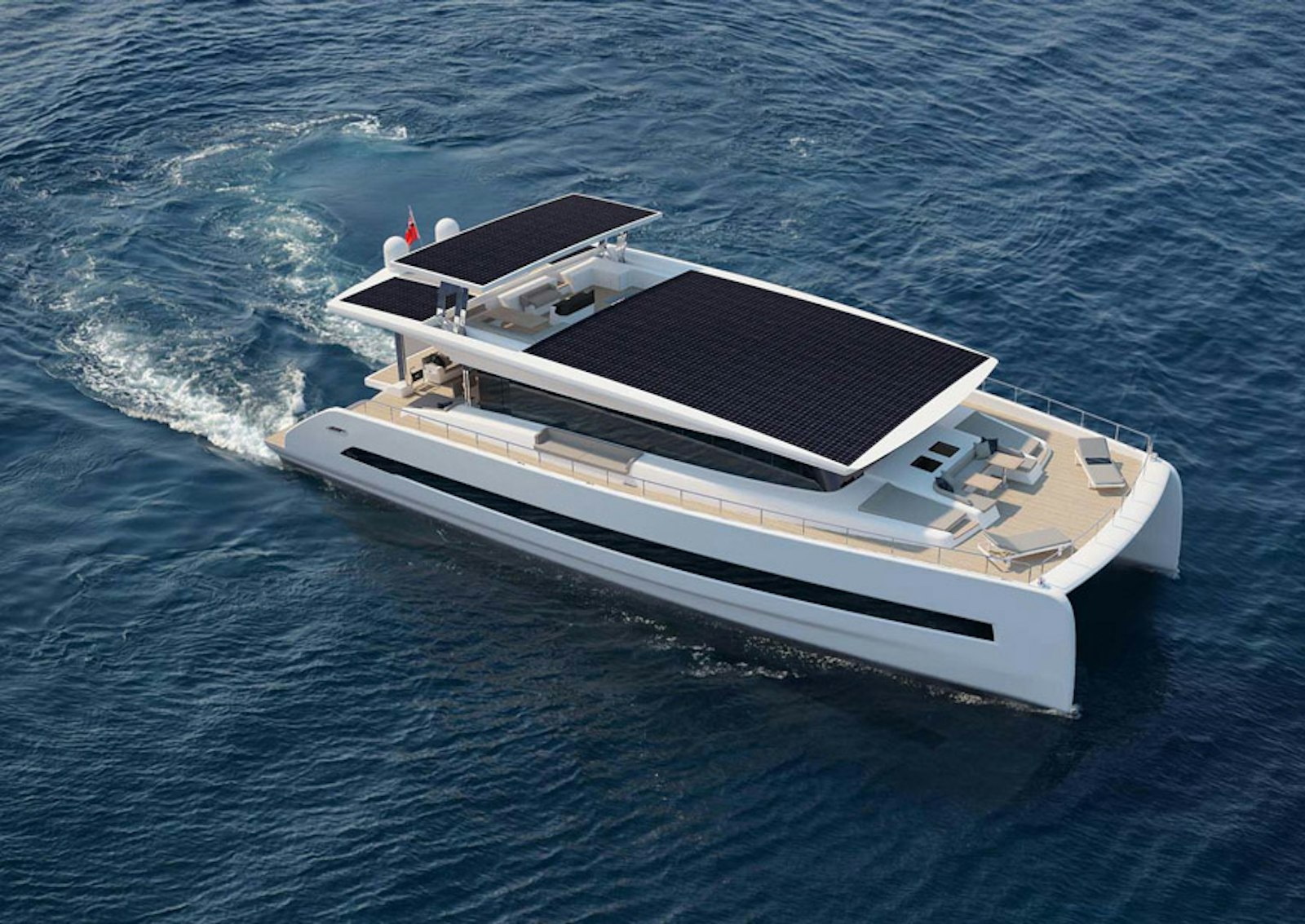
SPECIFICATIONS
- Length Overall 78' 6
- Max Draft 4' 1
- Displacement 96,000 Lbs.
- Water Capacity 264 Gallons
- Fuel Capacity 792.5 Gallons
The Silent Yachts 80 is the ultimate solar-powered catamaran with an unlimited cruising range. At 80 feet in length and a 35-foot beam, the Silent 80 has a massive platform for spacious living and cruising and thanks to the electric motors, can be done so in almost silence. This ocean-going power catamaran is fully solar sustainable and powered by solar energy. The Silent Yachts 80 offers the ultimate in luxury as well as customizable layouts for up to ten guests and crew members.
Here are just a few of the advantages of the Silent Yachts 80 Power Cat:
- 100% Solar-Powered
- Unlimited Cruising Range
- Limetime Maintenance-Free Motors
- Noiseless and Fume-less
- Full Electric Galley - No Propane or Gas
- Only The Highest Quality And Materials Used
- 25-Year Solar Panel Warranty
- 8-Year Battery Warranty
The Silent Yachts 80 is based on the dream of self-sufficient, worldwide cruising.
Worldwide Yacht Sales
- Azimut Yachts For Sale In Florida
- Used Yachts
- Used Edgewater Boats For Sale
- Sabre 54 For Sale
- Rybovich Yachts For Sale
- Viking Sport Fishing Yachts For Sale
Luxury Boats & Yachts
- Texas Yacht
- 150000 Yacht
- Garlington Express
- 45 Hatteras Sportfish
- Best Boats Under 100K
- 46 Ocean Yacht
Popular Builders & Models
- 50 Ft Yacht
- Hatteras Sportfish For Sale
- Live On Boats For Sale
- New Orleans Yacht Brokers
- Used Grand Banks Yachts
- Corsa Boats For Sale
- Used Steiger Craft Boats
- Young Boats For Sale
Trending Brands & Types
- Used Hatteras Yachts
- Where Are Kadey Krogen Yachts Built
- Used Contender
- Sport Fishing Yachts
- 50 Foot Silverton Motor Yacht
- Used Yellowfin Boats
Interested In This Yacht?
Contact United Yacht Sales below!

Silent Yachts 55
- Home Energy & Utilities
The Final Frontier for Renewable Energy: Marine Power
Oceans cover most of the earth. Tides, waves and currents could provide steady, clean energy if we can harness them.

- Finalist for the Nesta Tipping Point prize and a degree in broadcast journalism from the University of Missouri-Columbia.
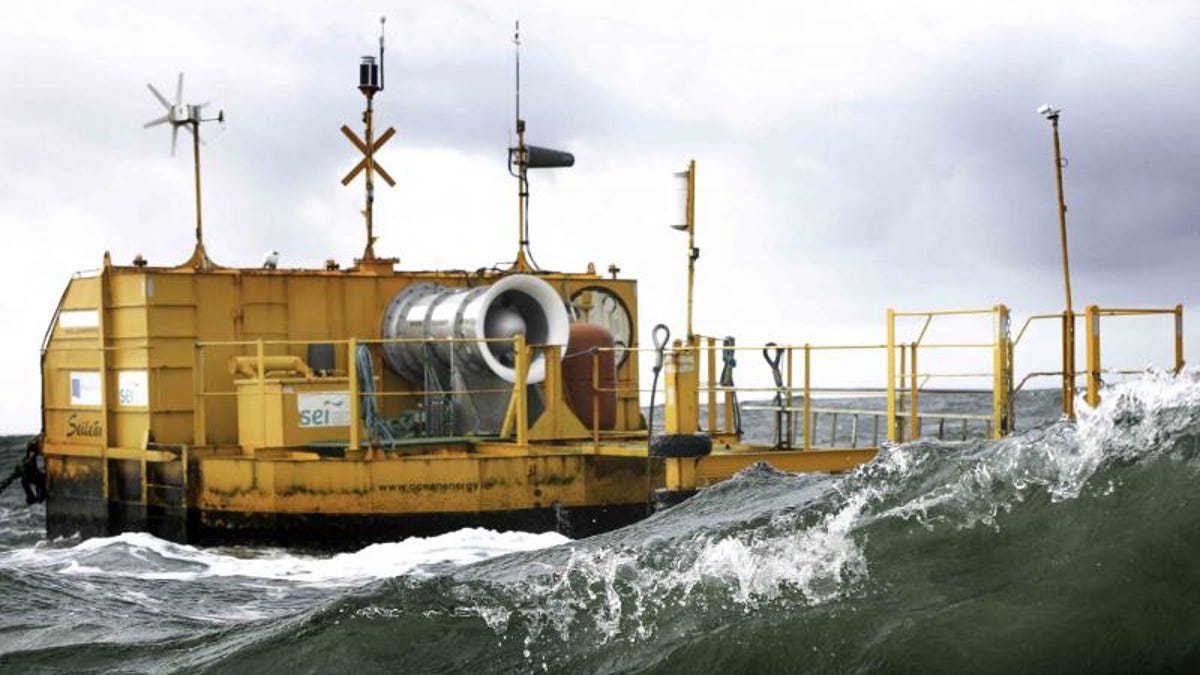
A buoy-based wave energy converter from wave energy technology company OceanEnergy.
If you've ever been knocked off your feet by a big wave, you've felt a smidgeon of the ocean's power.
Now imagine how wave power could be one of our largest energy resources -- an abundant resource with 70% of the Earth's surface covered by oceans.
For decades, scientists and engineers have looked to our vast oceans and dreamed of ways to extract a tiny fraction of that energy. In an era of climate awareness and anxiety, finding ways to do that is finally getting more attention.

The Biden administration's Ocean Climate Action Plan reveals how the ocean holds important potential for renewable energy, both from offshore wind power and less-explored sources such as waves, tides and currents. Even the chillier waters that lie deep below tropical seas could provide clean marine energy.
The plan acknowledges an ambitious endeavor nearing completion off the coast of Oregon, where 7 miles of conduit were laid under the floor of the Pacific Ocean using pioneering horizontal drilling techniques. Soon, thick cables will be run through that conduit to connect the mainland to PacWave , an offshore experimental testbed built to develop and demonstrate new technology that converts the power of waves into onshore electricity.
Once fully operational (as soon as 2025), PacWave could generate up to 20 megawatts, enough to power a few thousand homes. "I get really excited about wave energy because the resource is so large," Levi Kilcher, a senior scientist with the National Renewable Energy Laboratory, told me.
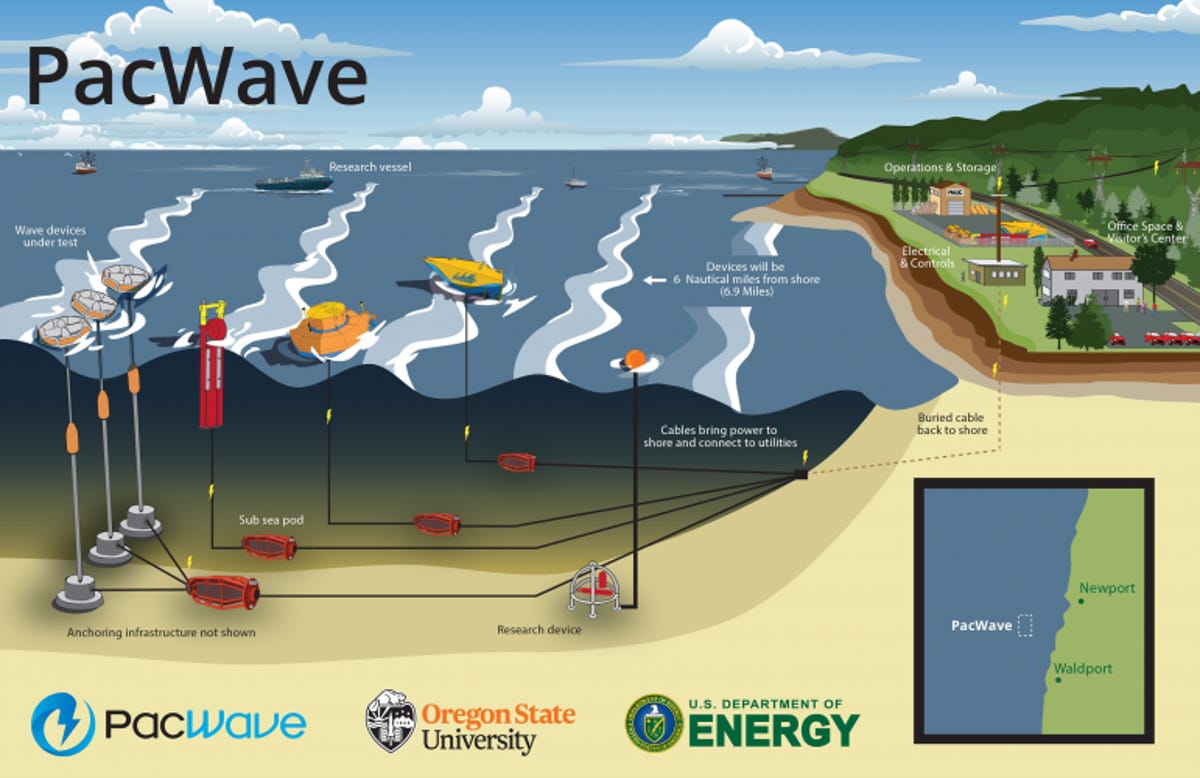
An illustration of PacWave's planned infrastructure.
Kilcher was a lead author on the 2021 NREL report that compiled available data on marine energy sources in the US, including waves, tides and ocean currents. The team found that the total energy potential is equal to more than half (57%) of the electricity generated in the US in a single year.
Though experimental sites like PacWave point to an efficient way to harvest wave power and could facilitate breakthroughs, wave energy still has a way to go before becoming a significant source of electricity. Though waves are steady, they aren't identical, posing a key challenge in designing a machine to capture their energy.
"You're trying to tune [the technological approach] so you can take advantage of these shifting kinds of waves," said Andrea Copping, a senior researcher at the Pacific Northwest National Laboratory.
Differing approaches to capturing wave energy include devices that ride the top of waves or ones that translate the pressure waves put on the seafloor into power. Another approach involves devices called oscillating water columns, which compress air as waves rush through them. That compressed air spins a turbine and generates energy.
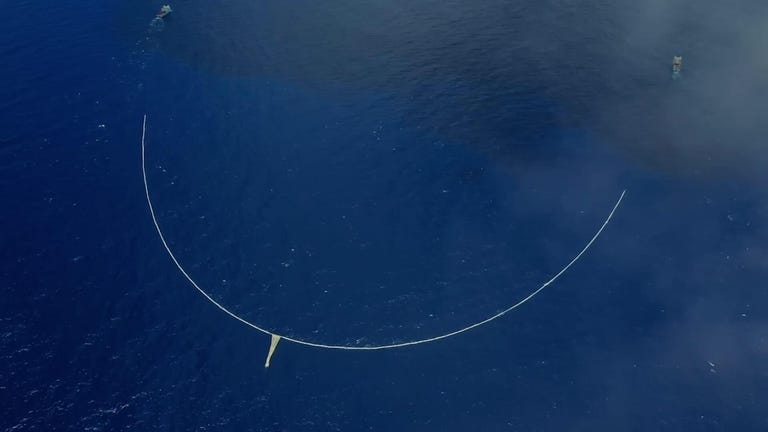
Power from the depths
Waves are just one potential source of marine energy that scientists and officials are investigating.
Copping says there's renewed interest in another form of marine energy: ocean thermal energy conversion, or OTEC , which involves bringing up colder water from deeper parts of the ocean. This chilly flow then goes through a heat exchange process with warmer surface water, similar to the way home heat pumps exchange hot and cold air. That process drives a turbine to generate electricity.
OTEC technology was pioneered in the 1970s when energy prices soared, but it never really caught on. According to Copping, climate change has led to more attention on OTEC, which could be a fit for islands like Puerto Rico, Guam and small nations in the South Pacific.
"There's a real interest, and we really think it's going to go this time," Copping said.
A small OTEC plant has been functioning in Hawaii for years. Copping believes new commitments from the US government hold promise for the future of the technology, which has also seen significant interest in Japan and other surrounding nations.
It's possible that concern over climate change could unlock new sources of funding for OTEC. In the meantime, building smaller facilities (10 megawatts or less) and putting them on land instead of floating on the ocean is making the tech more affordable, Copping said.
There's also the added bonus that the cold water pipes can double as a form of air conditioning in the tropical locales where OTEC works best.
Going with the flow
Much of the US coastline, like Alaska, the Pacific Northwest and the rocky shores of Maine, has climates where there's little chance of finding surface water warm enough for OTEC. Fortunately, some of these spots are optimal for generating power from a source that relies on shallower water: tides.
Growing up in Alaska, Kilcher was always fascinated by the power of tides. But he had no idea that nearby Cook Inlet is considered one of the world's ideal spots for harnessing their energy. When Kilcher first started work at the National Renewable Energy Laboratory, he was surprised when his colleagues informed him that this hometown of Homer, Alaska, was among the best tidal energy spots in the world.
When it comes to converting the ocean's movements into electricity, tidal energy technology is the most developed -- it's about as simple as putting the right turbine in the right place in the water. A number of tidal-power projects have already been deployed in Europe and elsewhere, as well as in niche applications around the world.
Tidal energy is the yin to the yang of wave energy. Waves can be anywhere and everywhere, but they're hard to predict. Tides are a mostly known quantity and are global, but their power potential is restricted to a few very specific places. The fast flows required to generate power are typically only found in narrow channels or between islands and the mainland. Still, where tidal energy works, it's a very reliable form of renewable energy.
"One thing that makes tidal energy especially attractive is it's 100% predictable," Kilcher said.
Waves (the tallest in red and shortest in blue) arrive along the west coast of the United States in this accelerated animation.
Some smaller experiments are being run with other consistent characteristics of oceans besides tides, like their major, slow-moving currents. Kilcher noted that research is underway off the coast of the southeastern US to examine how much power can be pulled out of currents before impacting heat circulation patterns in the North Atlantic.
"You don't want to be extracting so much energy that the Gulf Stream starts to shut down," he said. "These are the kind of scientific research questions that we look at."
Thar she blows
So far, effectively pulling power from the ocean has less to do with water than with the air above it. Offshore wind energy is by far the most productive source of power that we transfer from ocean to land.
"Offshore wind is the most mature technology without a doubt," Bryson Robertson, director of the Pacific Marine Energy Center at Oregon State University, told me. "We've been working on wind energy systems really since the birth of civilization. We were running sails [on boats], and we were using windmills to grind wheat."
Large, power-generating wind turbines anchored to the seafloor have become a familiar sight off the coast of the northeastern states and other locales. Robertson says that floating offshore wind turbines are a newer, promising technology that could help scale up the amount of electricity we literally pull out of thin air.
Wind is more consistent offshore, and floating infrastructure can be deployed in more parts of the world and on deeper seas. And taller turbines could access high-altitude winds in locations that are out of the view of the public.
Robertson believes the opportunities to generate more wind power from floating infrastructure are significant enough to make a real dent in carbon emissions.
A tough environment
Unlike developing a new mobile app or even a mobile phone, building the infrastructure to pull power from one of the most inhospitable and untamed environments on Earth can be a slow, difficult process.
"We know less about these tidal raises, these big wave areas because we stay out of them," Copping said. "That's one of the reasons this is taking time. But just look at the ocean -- it's hard not to see the energy potential."
There are also a number of other considerations, including the impacts marine energy infrastructure could have on wildlife, the broader environment, local populations, fishing and other industries.
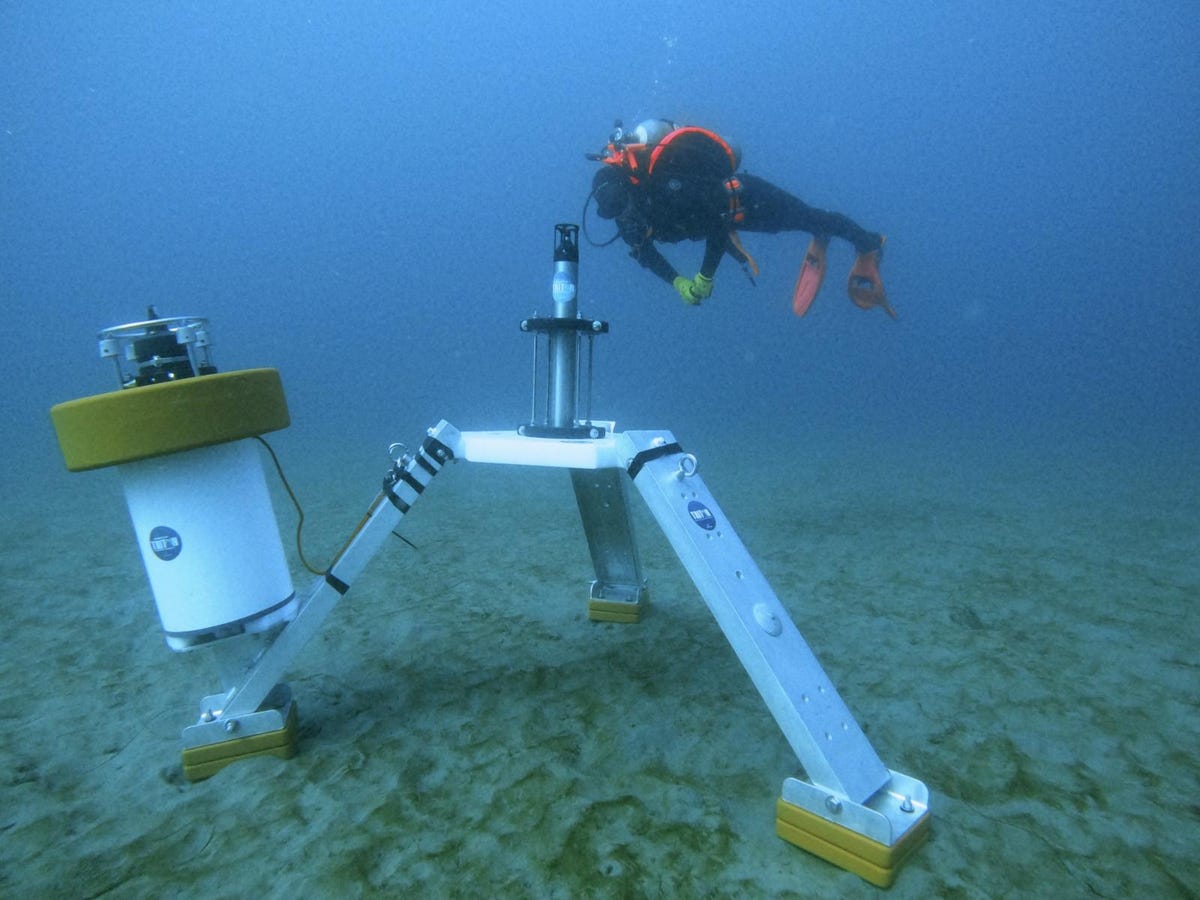
A research diver inspects a hydrophone lander deployed on the seafloor as part of ongoing research to improve the environmental monitoring of marine energy devices.
"I think the biggest issue is uncertainty," Robertson added. "We haven't done this at scale before, so what are the environmental impacts going to be?"
He says the policy process may be slow for good reasons, but the need for marine energy is still urgent.
"We need to find a way to deploy technology faster while being cognizant of the environment," he said. "We just need to find a way to accelerate this process if we're going to have a measurable impact on climate change."
Editor's note: This story was originally published on May 10, 2023. We're republishing it now to coincide with Earth Day and CNET's week-long focus on sustainability.
More on renewable energy
- What It Takes to Go Off the Grid With Solar Panels
- Best Solar Companies of 2024
- Solar Power Is Renewable Energy. Here's Why That Matters
- How Hundreds of 24-Ton Bricks Could Fix a Huge Renewable Energy Problem
- The Green Revolution Is Being Held Back by Red Tape
Solar Installer Guides
- Best Solar Panels
- Best Solar Batteries
- Most Efficient Solar Panels
- Best Solar Companies
- Best Solar Shingles
- Best Portable Solar Panels
- Best Solar Generators
- Best Solar Inverters
- Tesla Solar Panels Review
- Tesla Solar Roof Review
- Sunrun Solar Panels Review
- GAF Energy Review
- Sunnova Solar Review
- Smartflower Solar Review
- SunPower Review
- Trinity Solar Review
- ADT Solar Review
- Enphase Battery Review
- Tesla Powerwall Review
- Sunpower Sunvault Review
- Generac Pwrcell Review
- Sonnen Battery Review
- LG ESS Home 8 Review
- Panasonic Evervolt Battery Review
- Why Solar Panels Will Likely Keep Getting Cheaper
- How to Make Your Solar Panels Last Longer
- How the Solar Tax Credit Works
- How Much Do Solar Panels Cost?
- This Is How Many Solar Panels You'll Need to Power Your Home
- Solar Power Purchase Agreements Explained: The Pros and Cons
- Free Solar Panels: What's in the Fine Print?
- Avoid Solar Panel Scams: 7 Tips for Getting a Great Deal
- Solar Panels Will Eventually Save You Money. How to Know When the real Savings Begin
- This Is How Long You Can Expect Your Solar Panel Installation to Take
- The Pros and Cons of Solar Panels
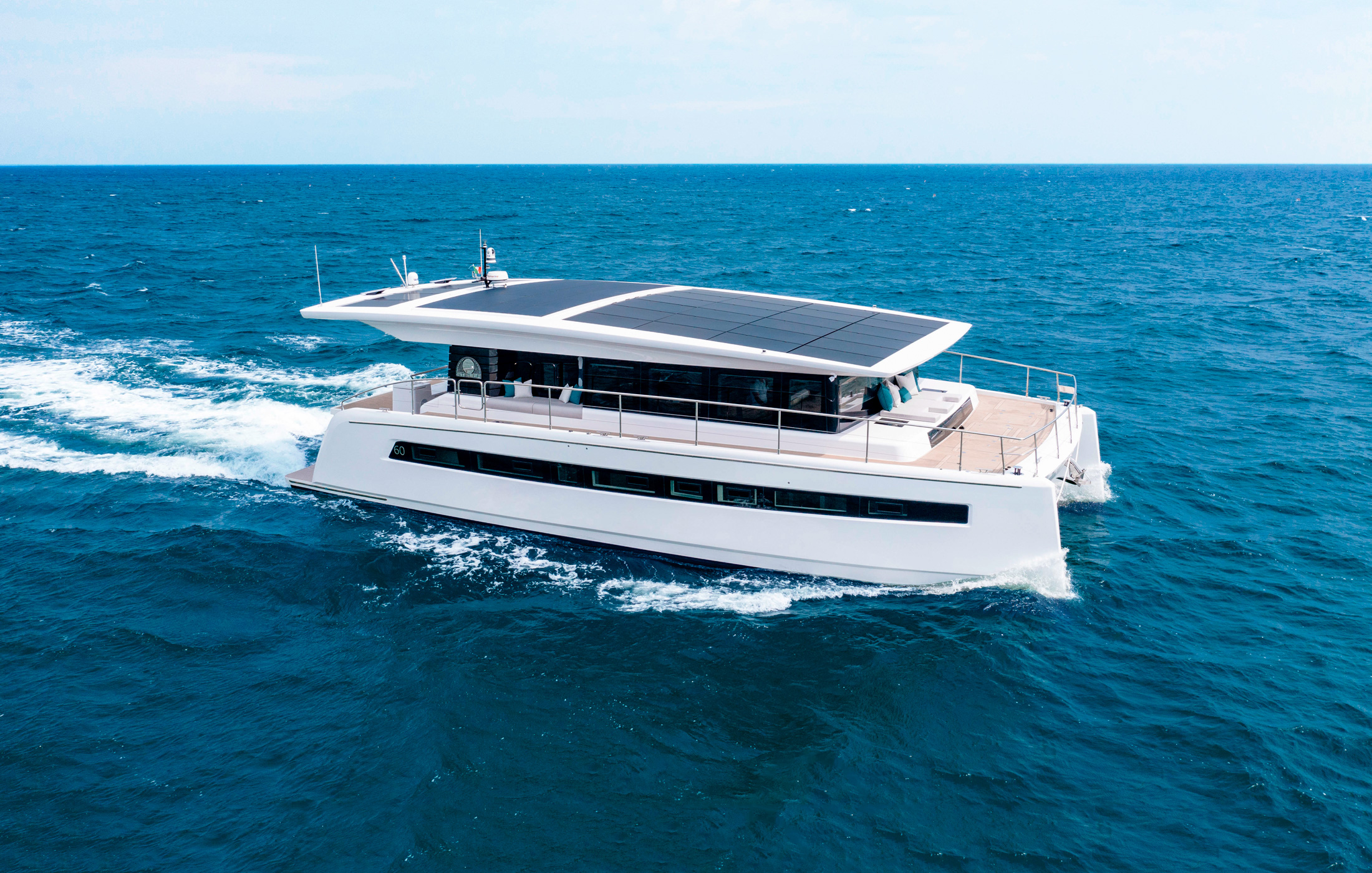
The award-winning entry to solar-electric yachts
As the successor to the Silent 64 (the first ever solar powered production yacht to cross the Atlantic Ocean during January of 2018), the 60 Series is equipped with the most refined, efficient and clever technology available today. Being a multi-award winner, including the prestigious “Best of Boats Award” in the category of ‘Best for Travel’, she embodies solar electric yachting in its purest form. Available in a variety of deck and cabin options, the Silent 60 is ideally suited for families cruising with or without additional crew.

Specifications
Deck options, silent 62 flybridge.
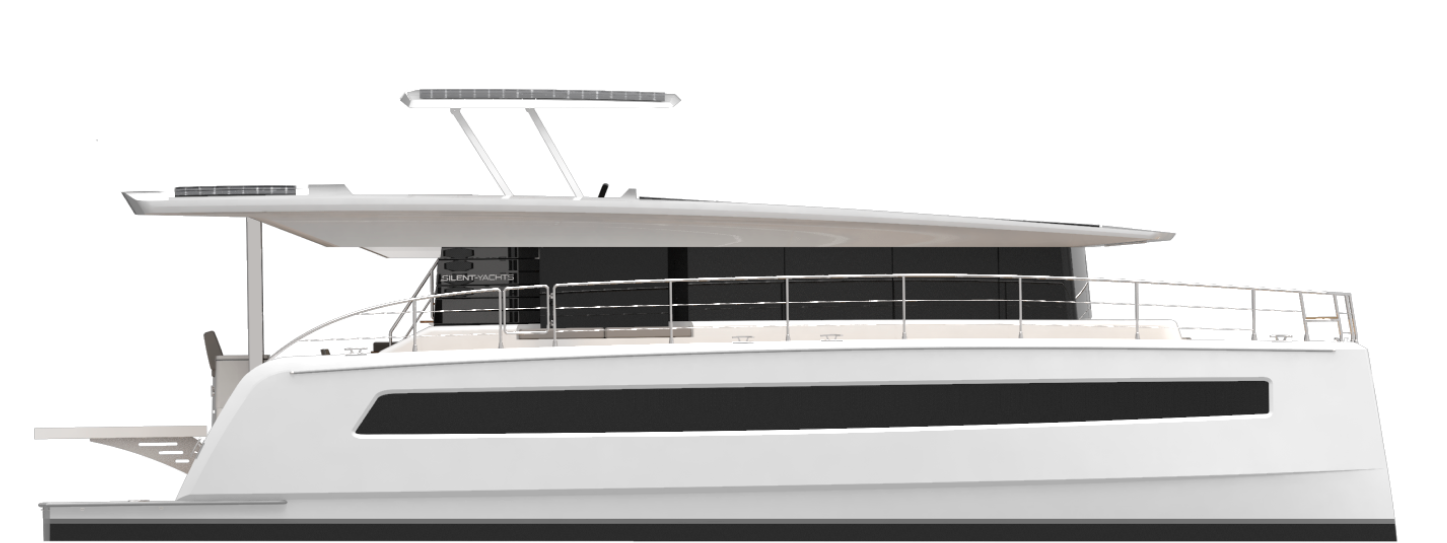
The flybridge version with a retractable roof offers enough space for a dining area with a small lounge and a dedicated helm station. For owners who do not need the additional space of the 62 3-deck configurations, the flybridge version offers enough space and outstanding 360° visibility.
Silent 62 3-Deck Open
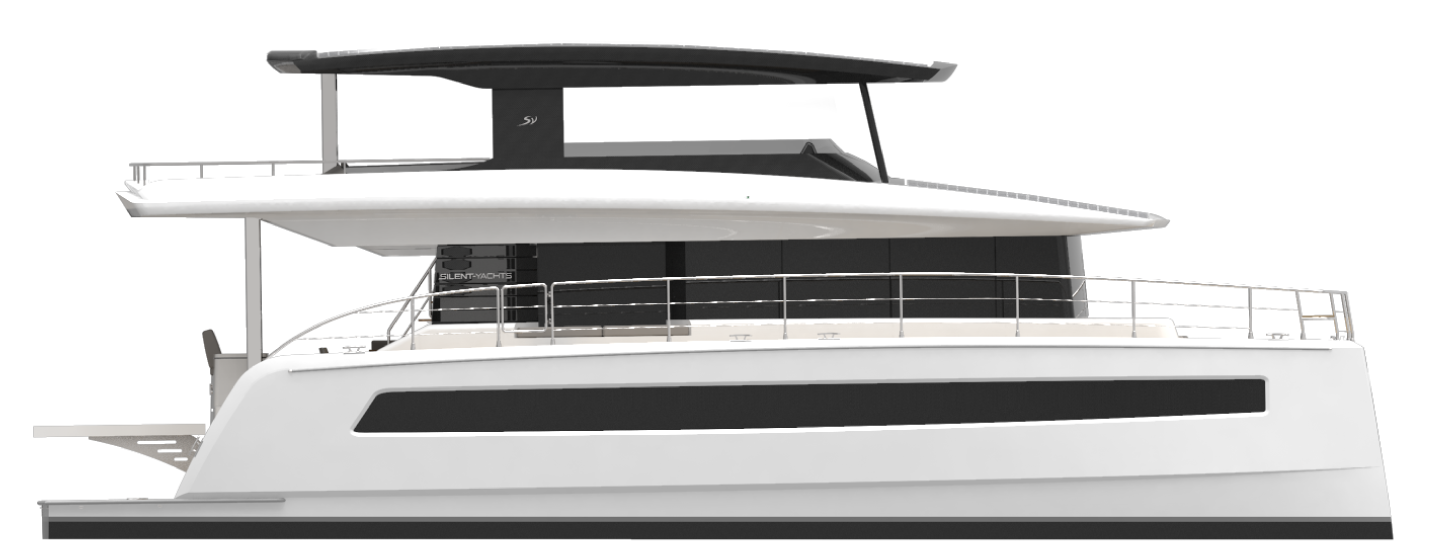
An additional open deck instead of the flybridge combines the benefits of larger catamarans with the compact dimensions of the 60 Series. The open sky lounge is a fantastic outdoor community space, equipped with a full dining area including a panoramic view and a superyacht atmosphere.
Silent 62 3-Deck Closed
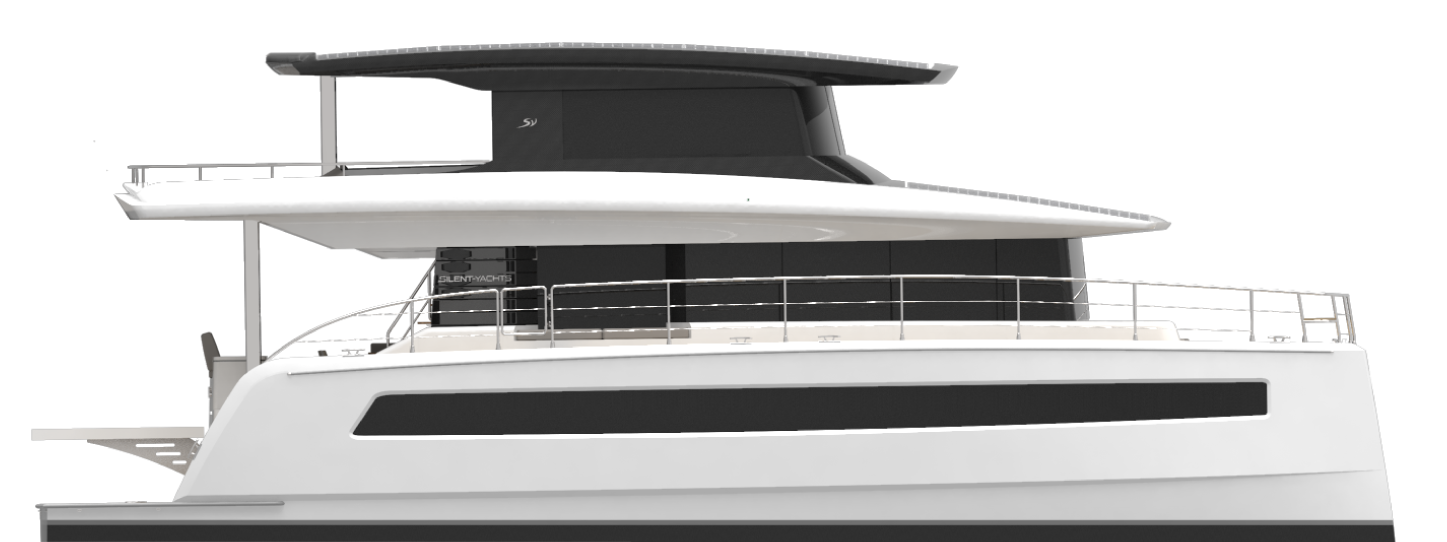
The closed version of the 62 3-Deck further develops her character as a compact superyacht. Providing additional indoor space, the closed third deck is available in two options: a choice between a sky lounge or an exclusive owner’s deck makes sure it can be tailored towards individual needs.
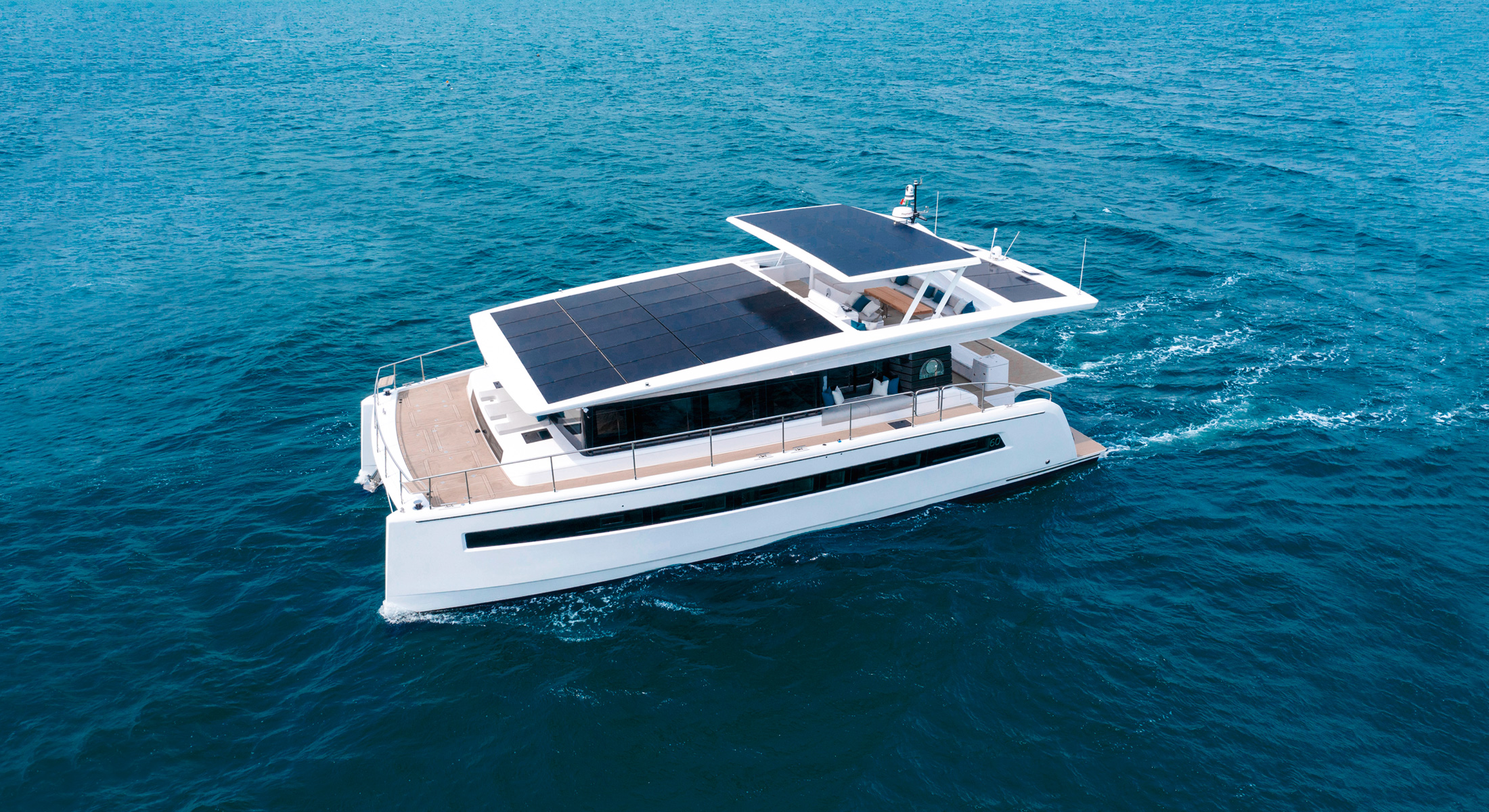
Model variations
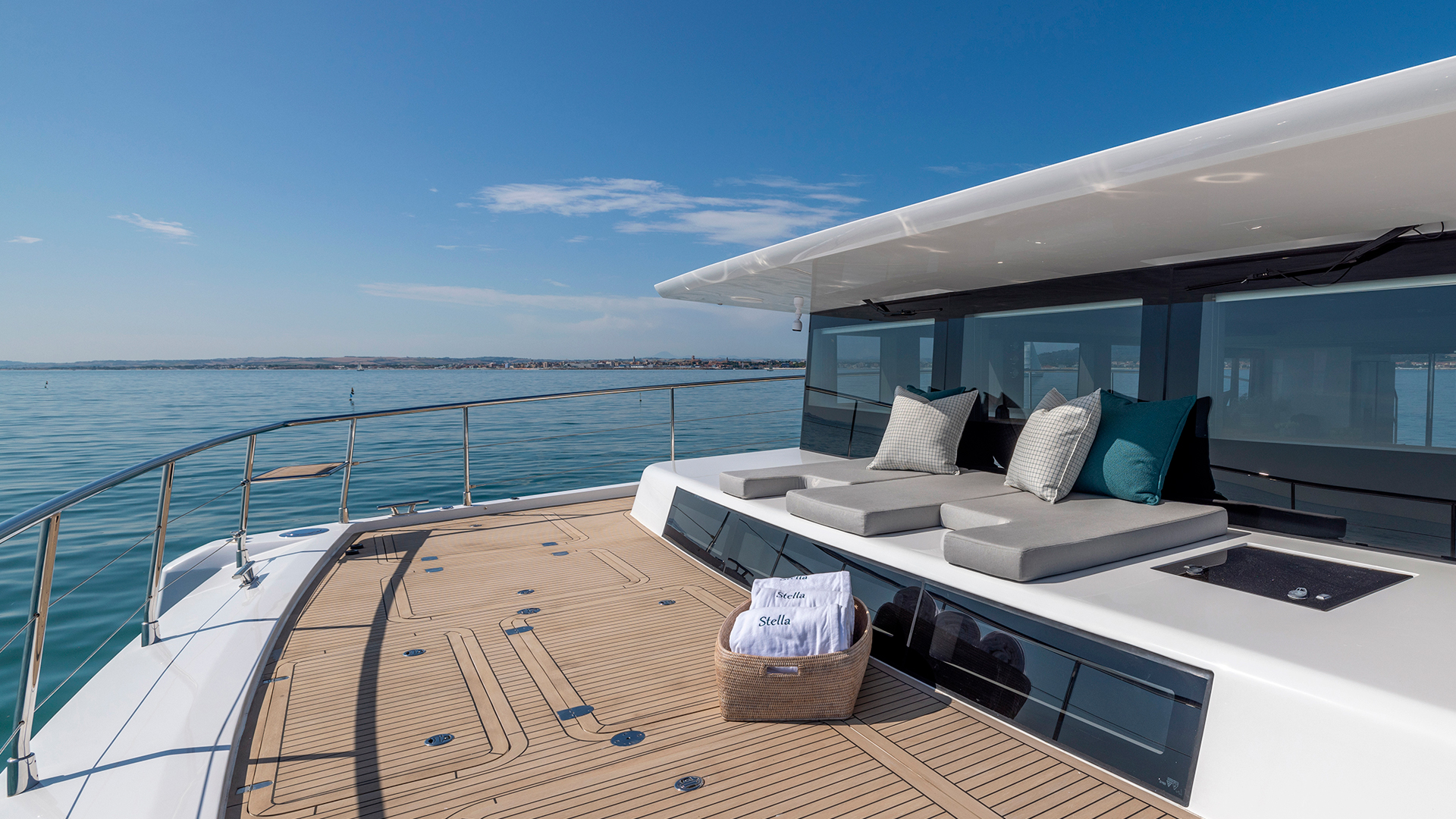
Front Master Version
- Available for every deck option (flybridge, 3-deck open & 3-deck closed versions)
The Master cabin is located below the bow in the front of the main deck. This replaces the additional exit in the front of the salon.
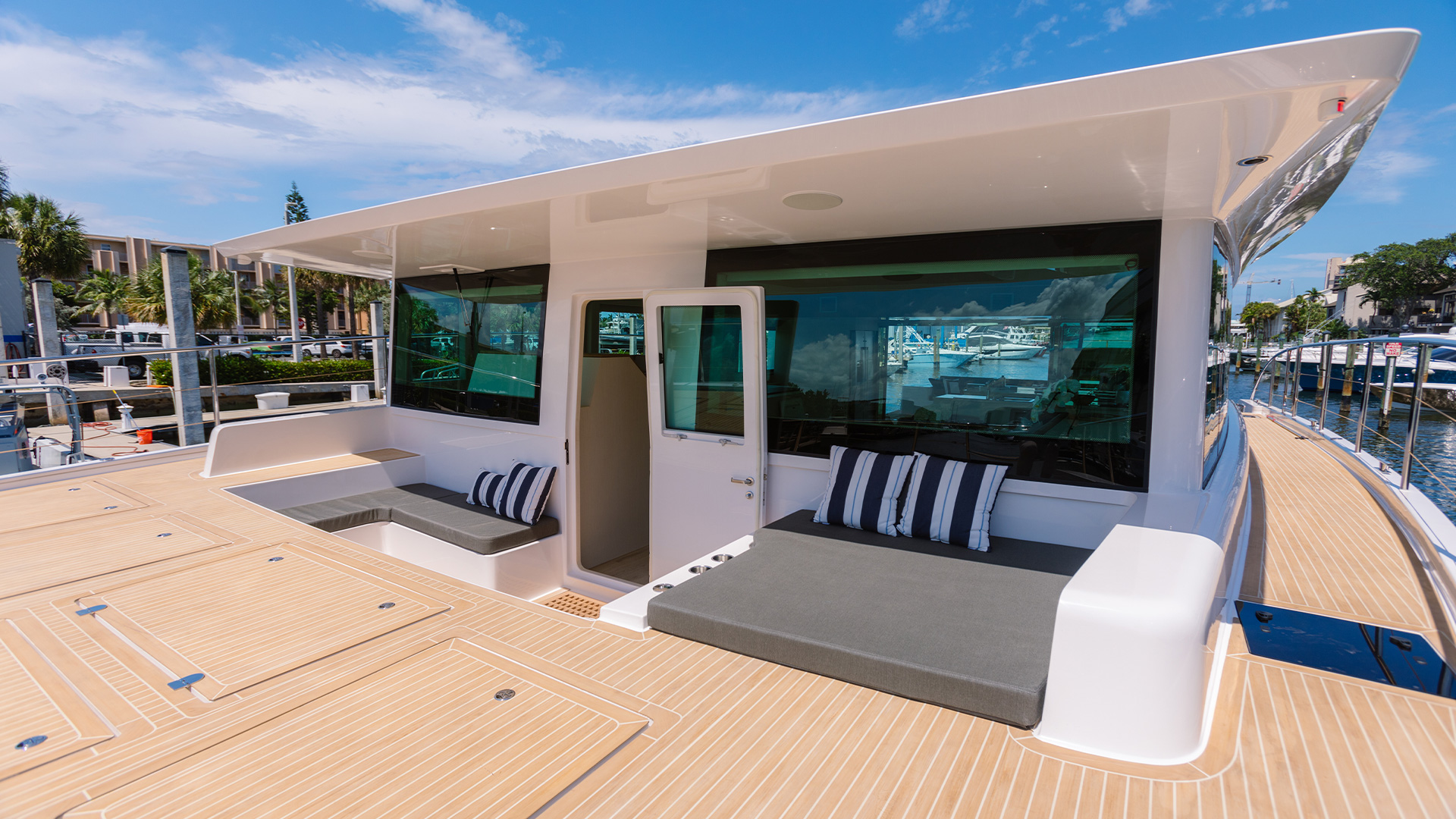
Front Exit Version
Hereby the salon on the main deck is equipped with an additional exit in the front. The Master cabin moves to the side of the hull in the lower deck.
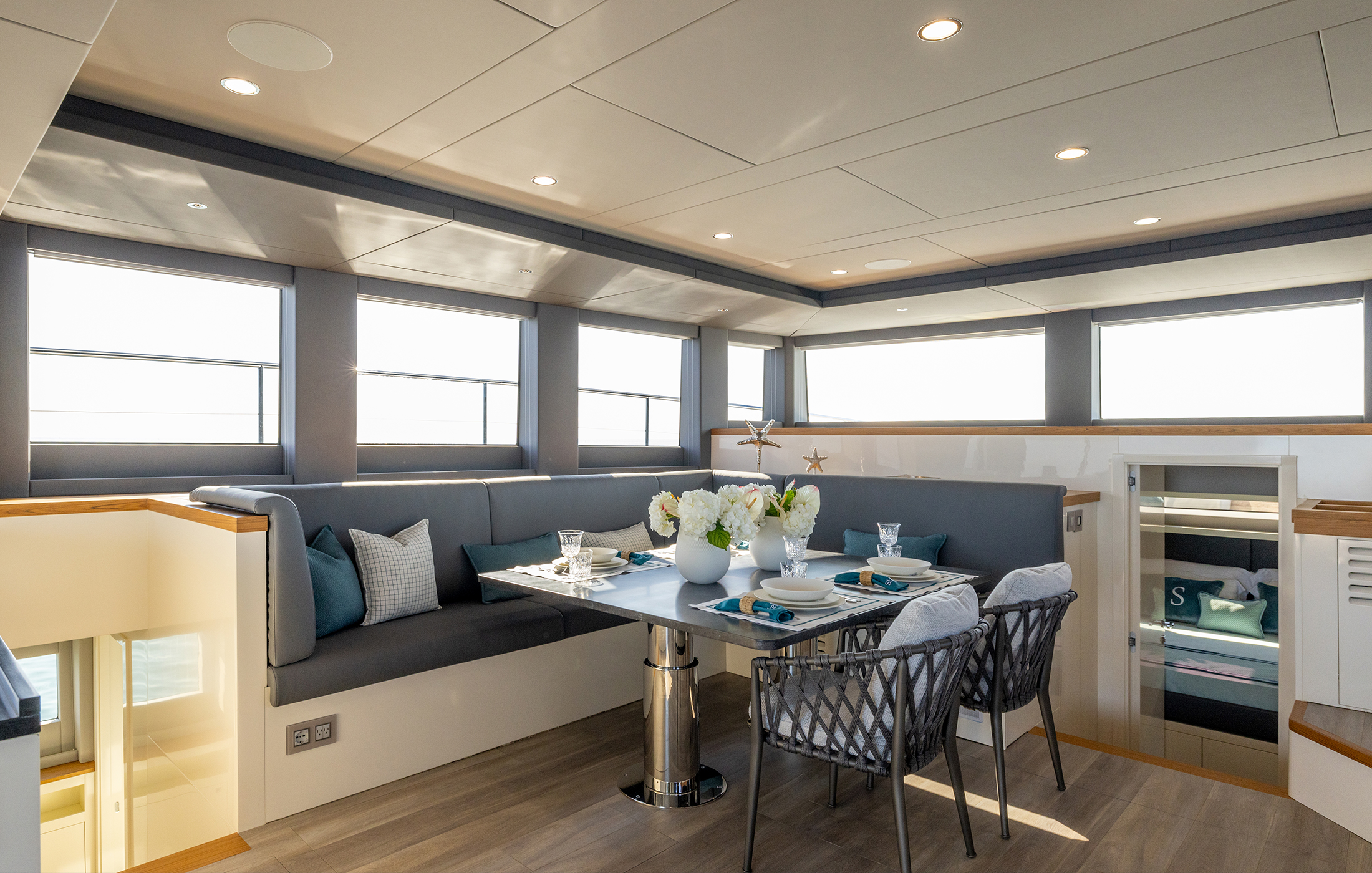
3-Deck Open
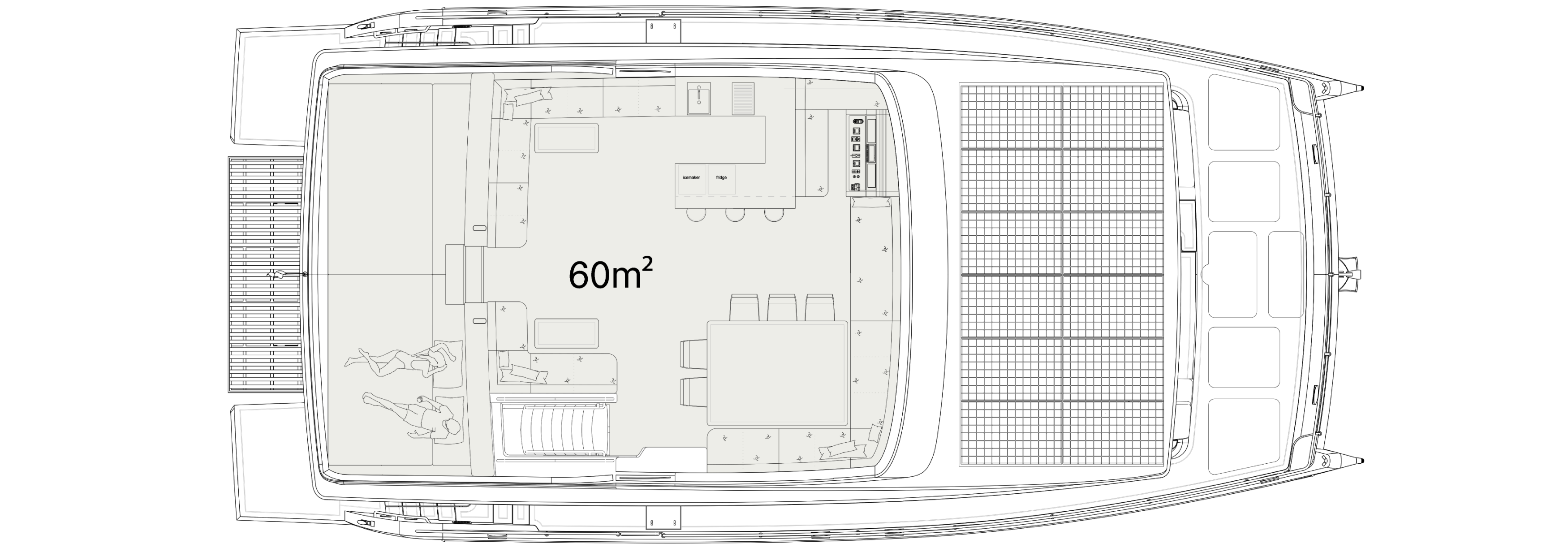
3-Deck Closed
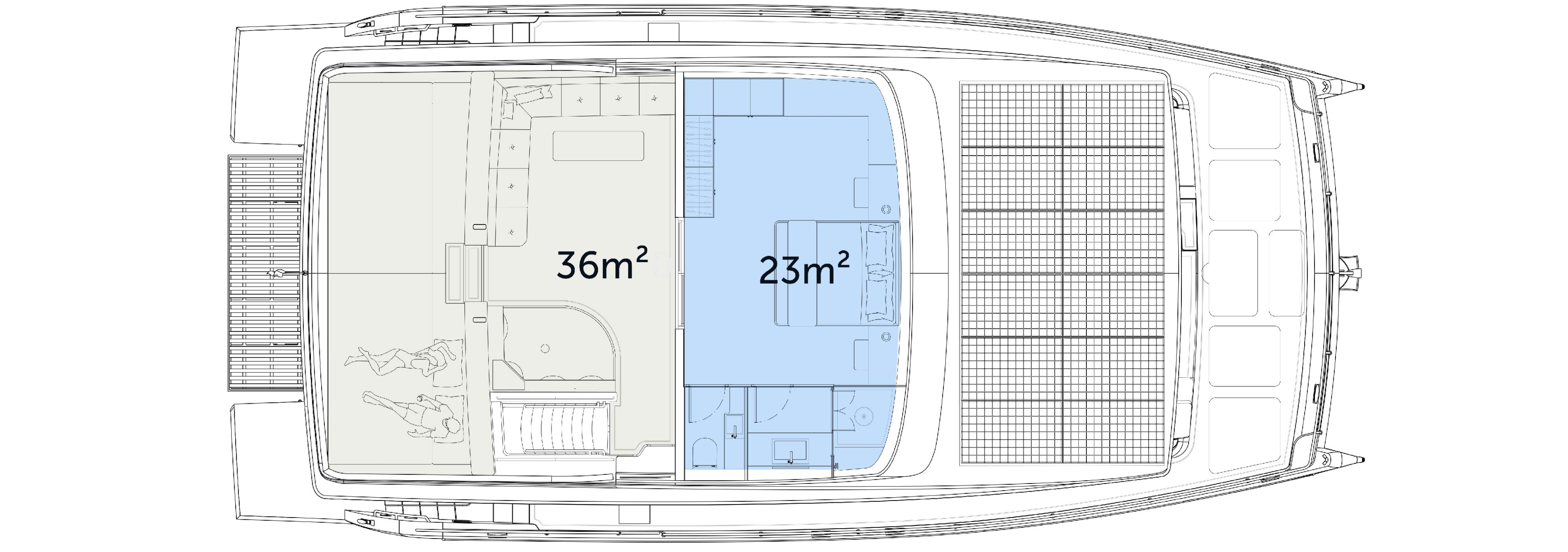
Front Master
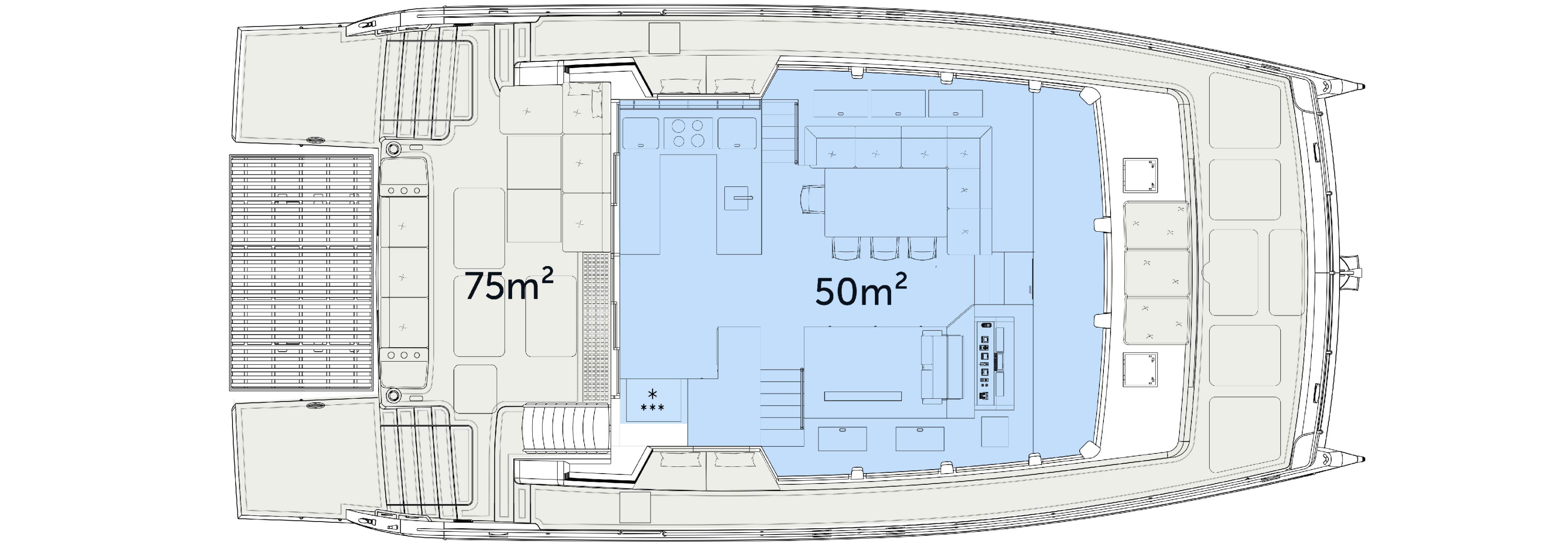
Solar-electric yachting advantages
Unlimited range, noiseless cruising, zero emission, minimal maintenance, powertrains, 6o series highlights.
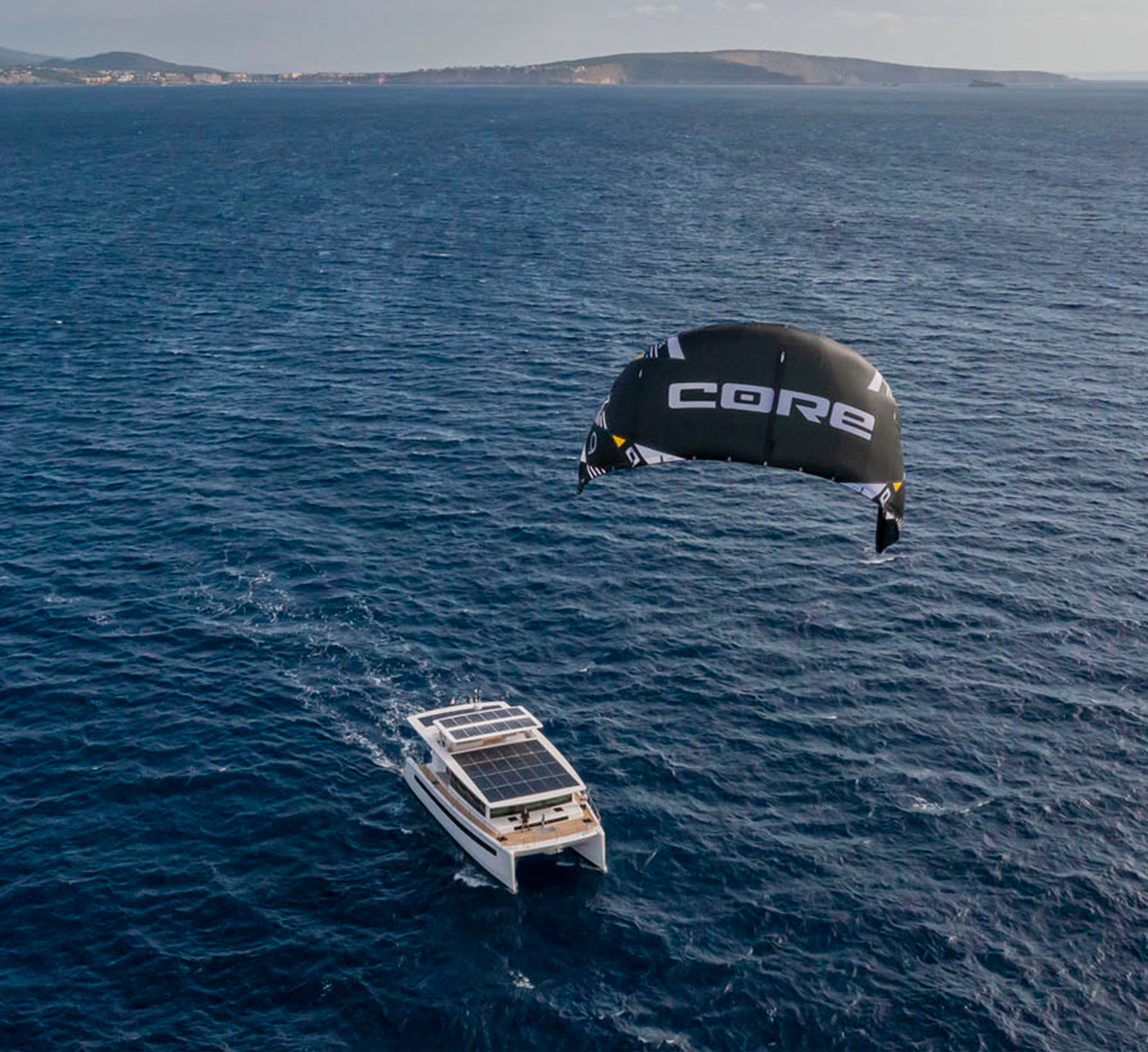
Kite sail system
Adding the option of a fully automatic towing kite gives the 60 Series the opportunity to make use of the wind without shading the panels. The either 9m² or 12 m² sized kite flies at heights where winds are much stronger, thus being able to create up to 10x more pulling power compared to a conventional sail.
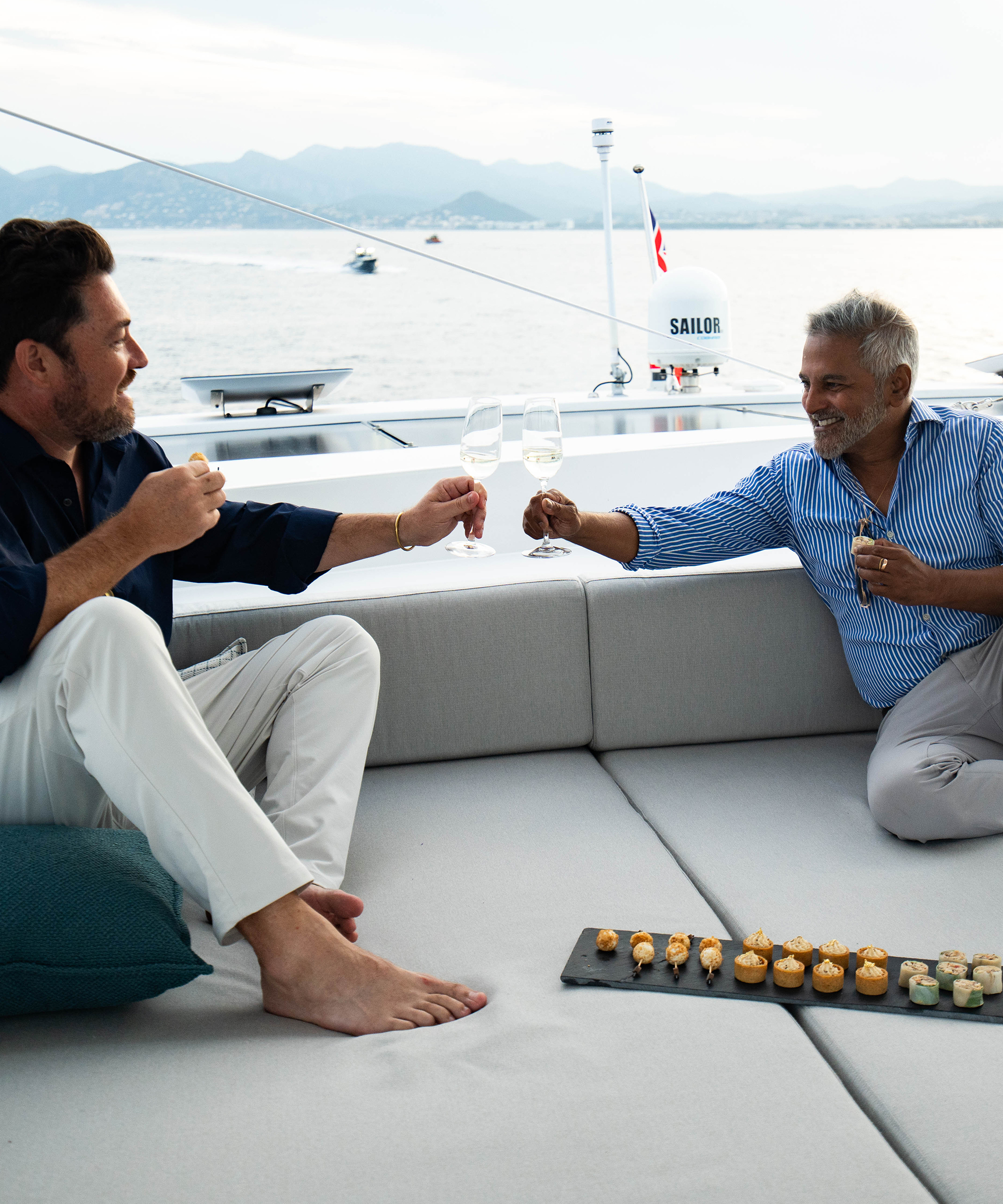
Self-sufficient lifestyle
Designed from the ground up to be fully autonomous. By being able to produce your own energy and water while making use of coolable food supplies for storage as well as a worldwide internet connection, you have the possibility of creating a fully self-sufficient lifestyle on board.
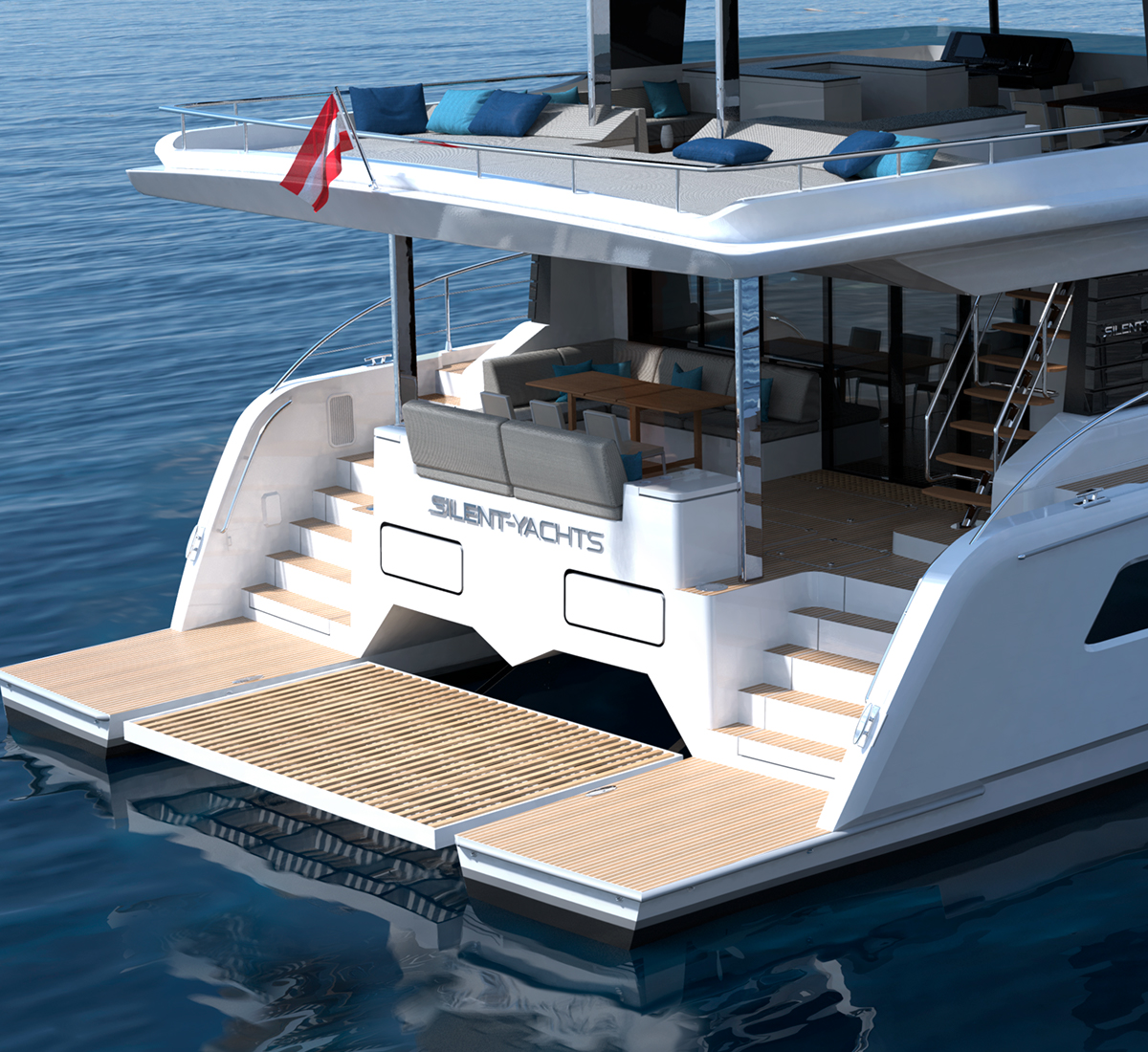
Bridgedeck storage
Under the bridge deck, there are two spacious storage boxes for SUPs, surfboards, small RIBs or compact sailboats. Both of them can be accessed either from the aft cockpit deck or directly from the hydraulic tender lift.
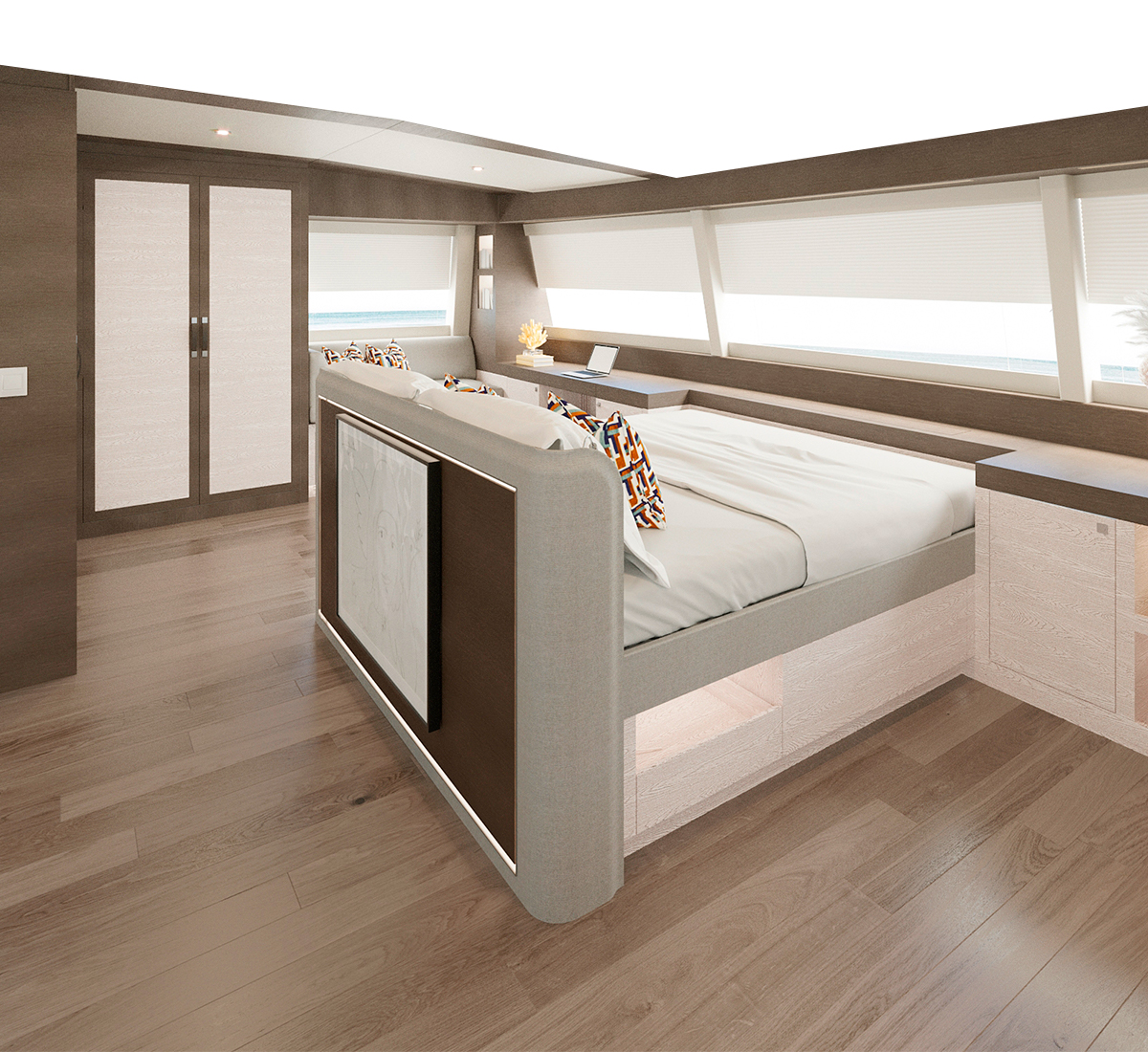
Owner's suite
Being able to design the 60 Series with an exclusive owner’s suite on the 3rd deck us unique amongst 60-foot catamarans. The suite itself is fully equipped with an en-suite bathroom and measures 23 m² in size. It also gives direct access to the 36 m² lounge area in the aft.
8 Years Warranty Battery Banks
4 0 years warranty solar panels, lifetime warranty electric motors, ce-a category certification, ocean crossing capabilities.
If you would like to enquire about this electric yacht and get in touch with a member of our team, please click on the button below.
Other models
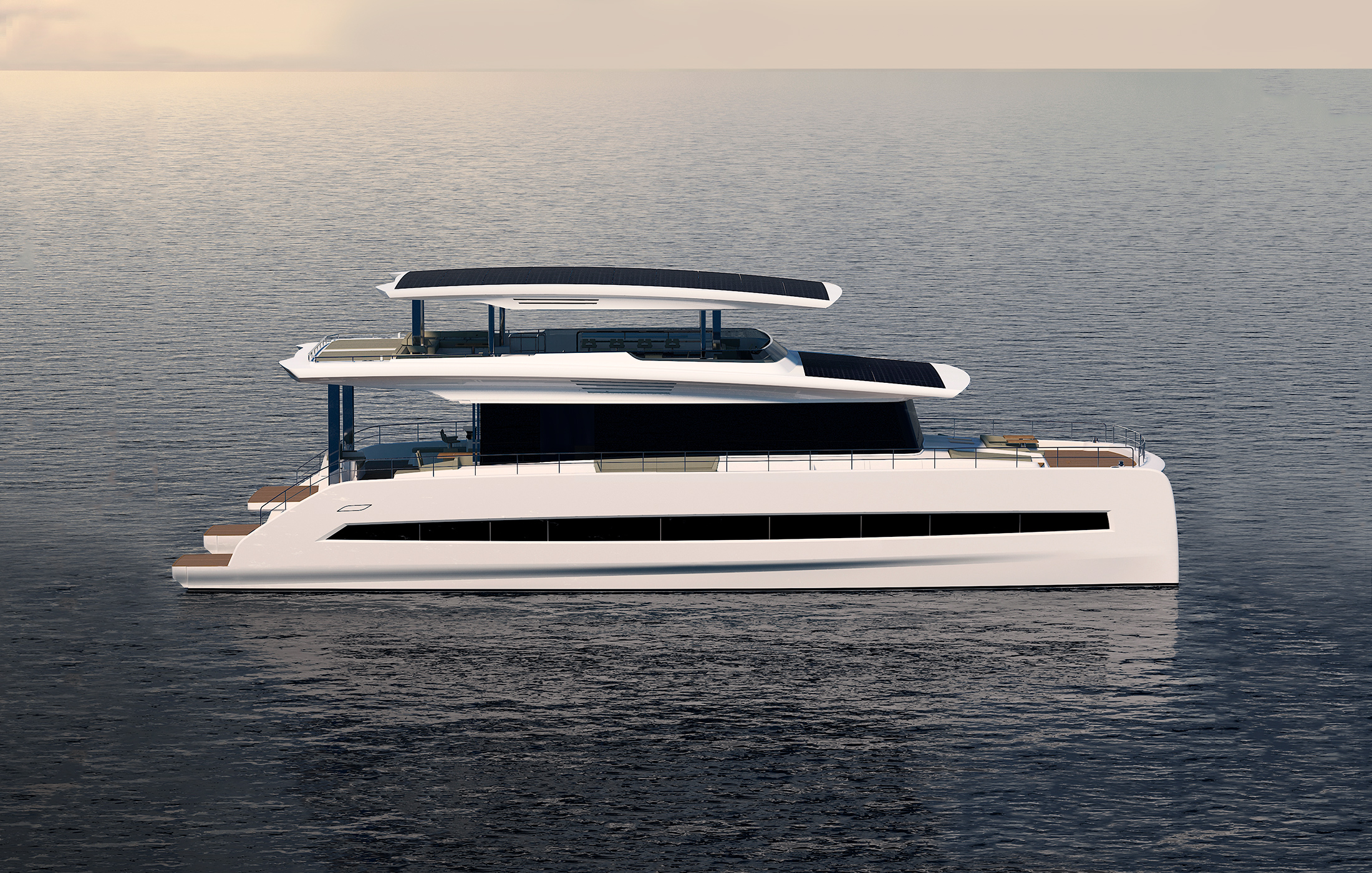
120 Explorer
Silent Group
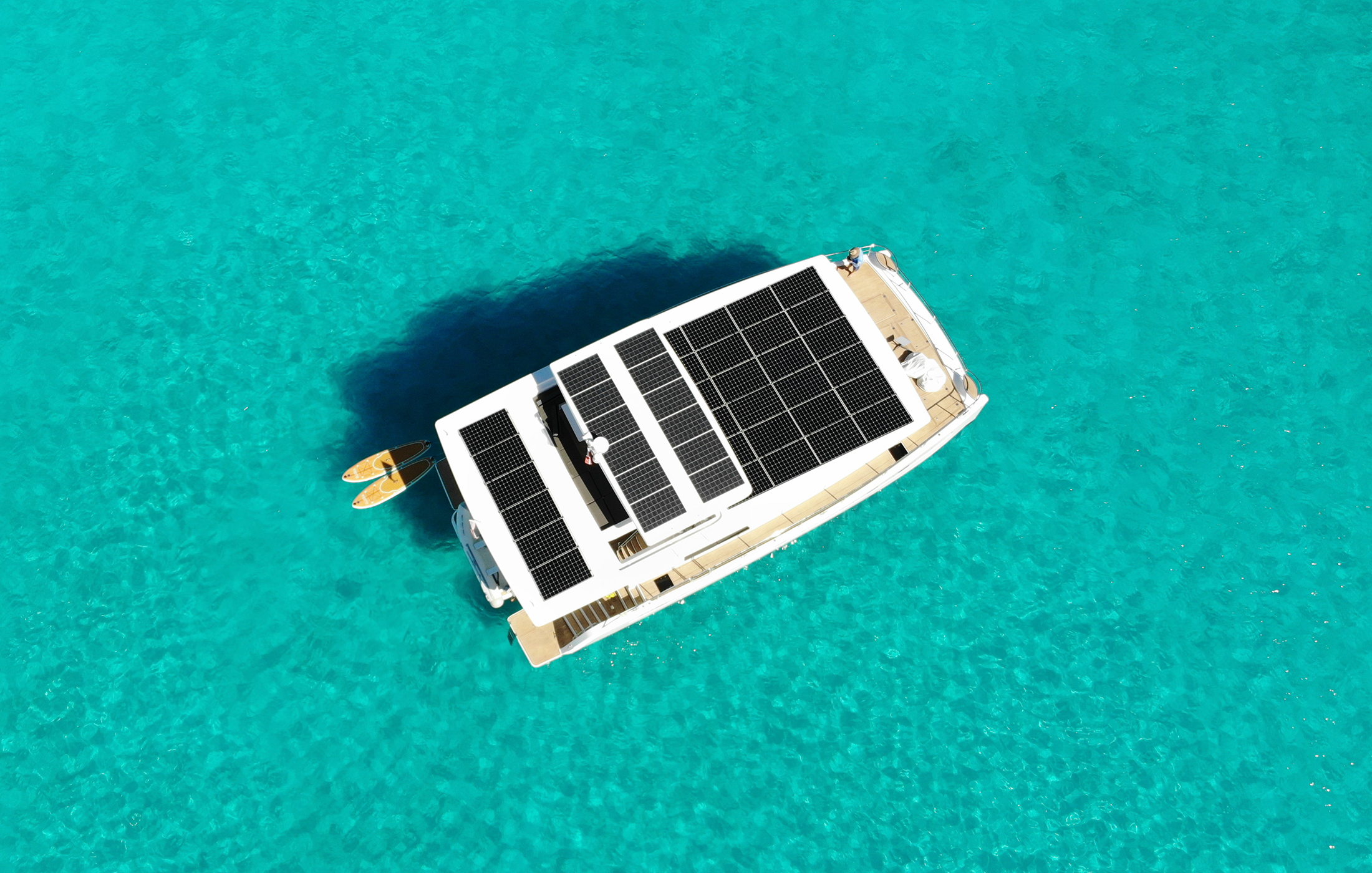
Our charters offer you the opportunity to book a memorable vacation on board of our electric yachts. Including our helpful crew, consisting of a captain and a chef, you will experience the comfort of solar powered yachting.
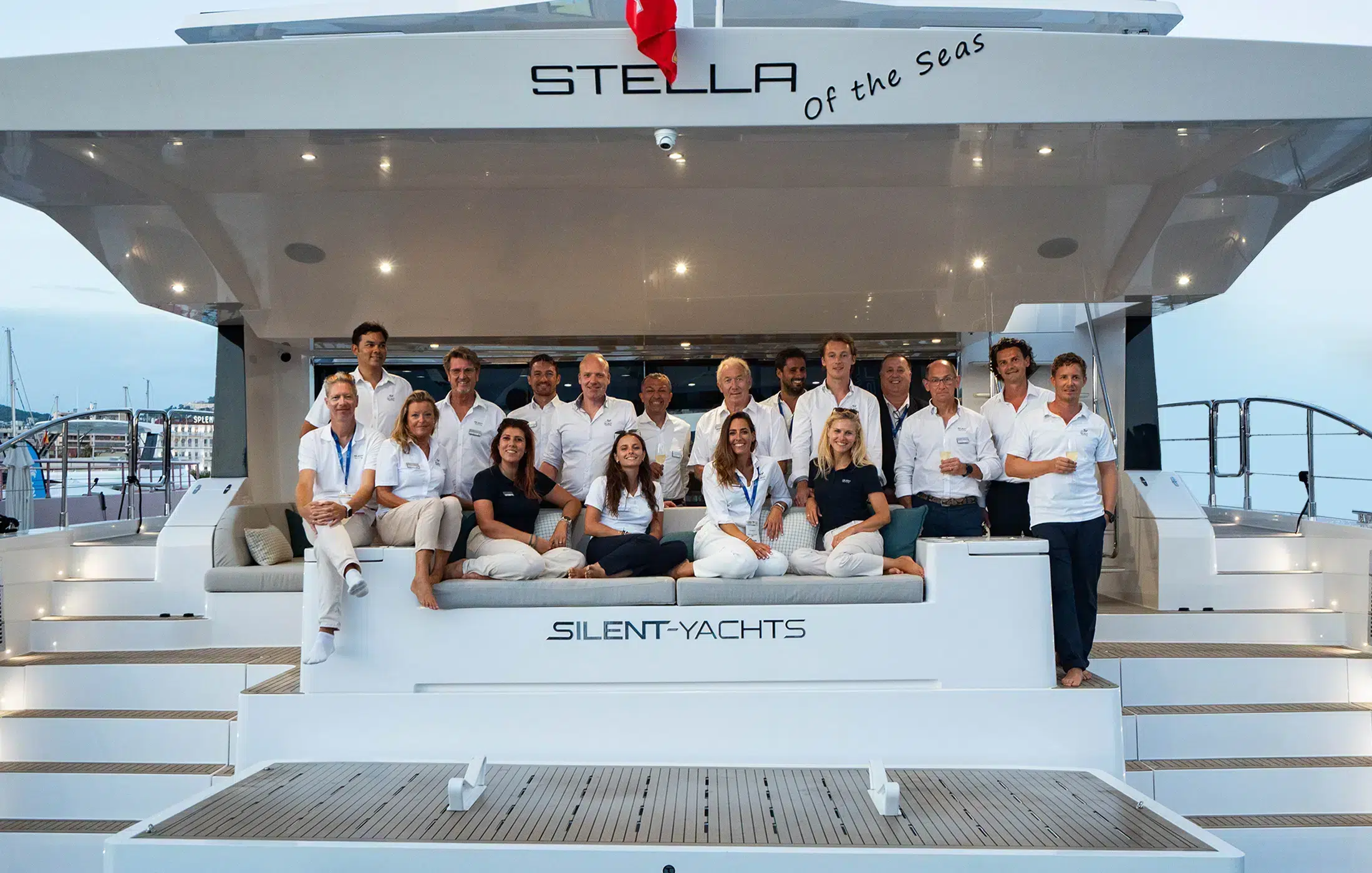
As the pioneers of solar yachting, we have almost three decades of experience regarding the research, design and build of electric yachts. Our team, shipyard and the hiring of new talent are the backbone of our operations.
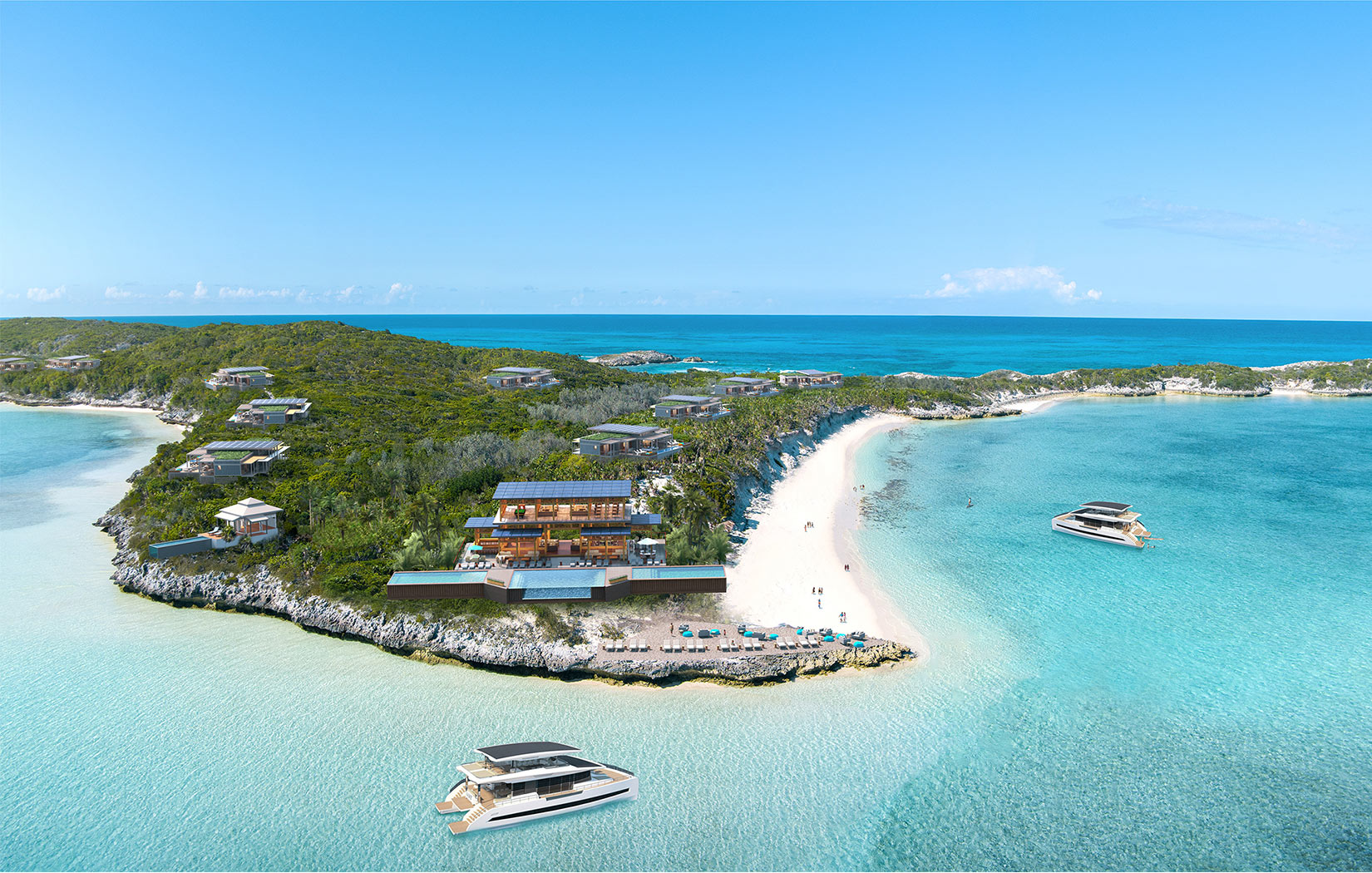
By transferring our solar yachting technology, Silent Resorts develops sustainable beachfront resorts in beautiful locations worldwide. Memberships offer full or part ownership of an eco-property and a Silent yacht.
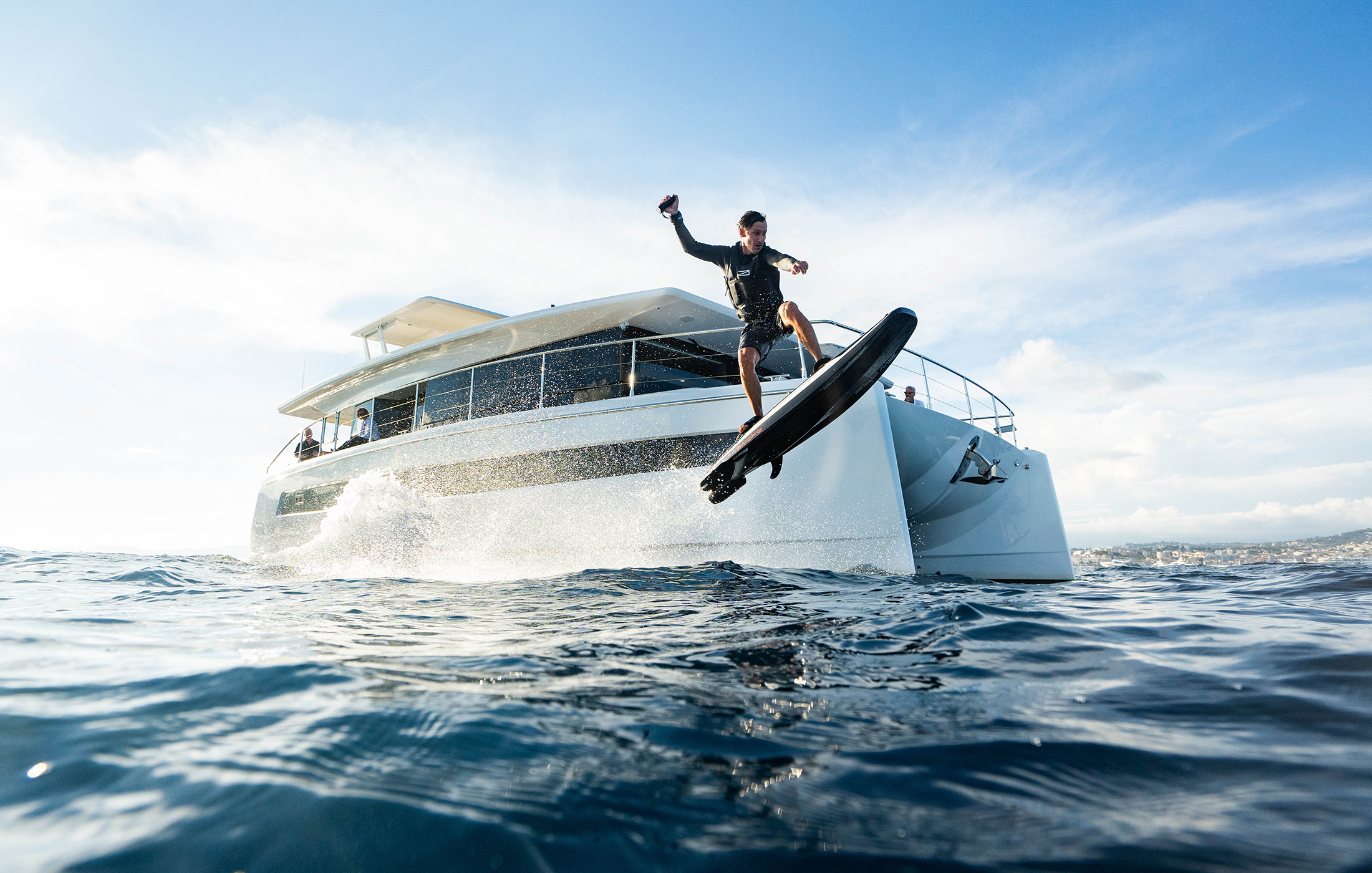
Create your infinite playground on the water. A selection of premium electric water toys, which can be recharged by simply connecting them to your Silent yacht, as well as other accessories for the ultimate experience on board.
- Share full article

Buying Time
Warming Is Getting Worse. So They Just Tested a Way to Deflect the Sun.
A spraying machine designed for cloud brightening on the flight deck of the Hornet, a decommissioned aircraft carrier that is now a museum in Alameda, Calif. Credit...
Supported by
By Christopher Flavelle
Photographs by Ian C. Bates
Christopher Flavelle reported from a decommissioned aircraft carrier in Alameda, Calif. He spoke with scientists, environmentalists and government officials.
- April 2, 2024
A little before 9 a.m. on Tuesday, an engineer named Matthew Gallelli crouched on the deck of a decommissioned aircraft carrier in San Francisco Bay, pulled on a pair of ear protectors, and flipped a switch.
A few seconds later, a device resembling a snow maker began to rumble, then produced a great and deafening hiss. A fine mist of tiny aerosol particles shot from its mouth, traveling hundreds of feet through the air.
It was the first outdoor test in the United States of technology designed to brighten clouds and bounce some of the sun’s rays back into space, a way of temporarily cooling a planet that is now dangerously overheating. The scientists wanted to see whether the machine that took years to create could consistently spray the right size salt aerosols through the open air, outside of a lab.
If it works, the next stage would be to aim at the heavens and try to change the composition of clouds above the Earth’s oceans.
As humans continue to burn fossil fuels and pump increasing amounts of carbon dioxide into the atmosphere, the goal of holding global warming to a relatively safe level, 1.5 degrees Celsius compared with preindustrial times, is slipping away. That has pushed the idea of deliberately intervening in climate systems closer to reality.
Universities, foundations, private investors and the federal government have started to fund a variety of efforts, from sucking carbon dioxide out of the atmosphere to adding iron to the ocean in an effort to store carbon dioxide on the sea floor.
“Every year that we have new records of climate change, and record temperatures, heat waves, it’s driving the field to look at more alternatives,” said Robert Wood, the lead scientist for the team from the University of Washington that is running the marine cloud brightening project. “Even ones that may have once been relatively extreme.”
Brightening clouds is one of several ideas to push solar energy back into space — sometimes called solar radiation modification, solar geoengineering, or climate intervention. Compared with other options, such as injecting aerosols into the stratosphere, marine cloud brightening would be localized and use relatively benign sea salt aerosols as opposed to other chemicals.
And yet, the idea of interfering with nature is so contentious, organizers of Tuesday’s test kept the details tightly held, concerned that critics would try to stop them. Although the Biden administration is funding research into different climate interventions, including marine cloud brightening, the White House distanced itself from the California study, sending a statement to The New York Times that read: “The U.S. government is not involved in the Solar Radiation Modification (SRM) experiment taking place in Alameda, CA, or anywhere else.”
David Santillo, a senior scientist at Greenpeace International, is deeply skeptical of proposals to modify solar radiation. If marine cloud brightening were used at a scale that could cool the planet, the consequences would be hard to predict, or even to measure, he said.
“You could well be changing climatic patterns, not just over the sea, but over land as well,” he said. “This is a scary vision of the future that we should try and avoid at all costs.”

Karen Orenstein, director of the Climate and Energy Justice Program at Friends of the Earth U.S., a nonprofit environmental group, called solar radiation modification “an extraordinarily dangerous distraction.” She said the best way to address climate change would be to quickly pivot away from burning fossil fuels.
On that last point, the cloud researchers themselves agree.
“I hope, and I think all my colleagues hope, that we never use these things, that we never have to,” said Sarah Doherty, an atmospheric scientist at the University of Washington and the manager of its marine cloud brightening program.
She said there were potential side effects that still needed to be studied, including changing ocean circulation patterns and temperatures, which might hurt fisheries. Cloud brightening could also alter precipitation patterns, reducing rainfall in one place while increasing it elsewhere.
But it’s vital to find out whether and how such technologies could work, Dr. Doherty said, in case society needs them. And no one can say when the world might reach that point.
In 1990, a British physicist named John Latham published a letter in the journal Nature, under the heading “Control of Global Warming?,” in which he introduced the idea that injecting tiny particles into clouds could offset rising temperatures.
Dr. Latham later attributed his idea to a hike with his son in Wales, where they paused to look at clouds over the Irish Sea.
“He asked why clouds were shiny at the top but dark at the bottom,” Dr. Latham told the BBC in 2007 . “I explained how they were mirrors for incoming sunlight.”
Dr. Latham had a proposal that may have seemed bizarre: create a fleet of 1,000 unmanned, sail-powered vessels to traverse the world’s oceans and continuously spray tiny droplets of seawater into the air to deflect solar heat away from Earth.
The idea is built on a scientific concept called the Twomey effect: Large numbers of small droplets reflect more sunlight than small numbers of large droplets. Injecting vast quantities of minuscule aerosols, in turn forming many small droplets, could change the composition of clouds.
“If we can increase the reflectivity by about 3 percent, the cooling will balance the global warming caused by increased C02 in the atmosphere,” Dr. Latham, who died in 2021 , told the BBC. “Our scheme offers the possibility that we could buy time.”
A version of marine cloud brightening already happens every day, according to Dr. Doherty.
As ships travel the seas, particles from their exhaust can brighten clouds, creating “ship tracks,” behind them. In fact, until recently, the cloud brightening associated with ship tracks offset about 5 percent of climate warming from greenhouse gases, Dr. Doherty said.
Ironically, as better technology and environmental regulations have reduced the pollution emitted by ships, that inadvertent cloud brightening is fading, as well as the cooling that goes along with it.
A deliberate program of marine cloud brightening could be done with sea salts, rather than pollution, Dr. Doherty said.
Brightening clouds is no easy task. Success requires getting the size of the aerosols just right: Particles that are too small would have no effect, said Jessica Medrado, a research scientist working on the project. Too big and they could backfire, making clouds less reflective than before. The ideal size are submicron particles about 1/700th the thickness of a human hair, she said.
Next, you need to be able to expel a lot of those correctly sized aerosols into the air: A quadrillion particles, give or take, every second. “You cannot find any off-the-shelf solution,” Dr. Medrado said.
The answer to that problem came from some of the most prominent figures in America’s technology industry.
In 2006, the Microsoft founder, Bill Gates, got a briefing from David Keith, one of the leading researchers in solar geoengineering, which is the idea of trying to reflect more of the sun’s rays. Mr. Gates began funding Dr. Keith and Ken Caldeira, another climate scientist and a former software developer, to further their research.
The pair considered the idea of marine cloud brightening but wondered if it was feasible.
So they turned to Armand Neukermans, a Silicon Valley engineer with a doctorate in applied physics from Stanford and 74 patents. One of his early jobs was at Xerox, where he devised a system to produce and spray ink particles for copiers. Dr. Caldeira asked if he could develop a nozzle that would spray not ink, but sea salt aerosols.
Intrigued, Dr. Neukermans, who is now 83, lured some of his old colleagues out of retirement and began research in a borrowed lab in 2009, with $300,000 from Mr. Gates. They called themselves the Old Salts.
The team worked on the problem for years, eventually landing on a solution: By pushing air at extremely high pressure through a series of nozzles, they could create enough force to smash salt crystals into exceedingly small particles of just the right size.
Their work moved to a larger laboratory at the Palo Alto Research Center, a former Xerox research facility now owned by SRI International, a independent nonprofit research institute. Dr. Medrado became the lead engineer for the project two years ago. By the end of last year, the sprayer had been assembled and was waiting in a warehouse near San Francisco.
The machine was ready. The team needed somewhere to test it.
As the researchers were perfecting the sprayer, a profound transformation was happening outside their laboratory.
Since Dr. Latham first proposed the idea of marine cloud brightening, the concentration of heat-trapping gases in the atmosphere has increased by about 20 percent. Last year was the hottest in recorded history and the World Meteorological Organization projects that 2024 will be another record year . Global ocean temperatures have been at record highs for the past year.
As the effects of climate change continue to grow, so has interest in some sort of backup plan. In 2020, Congress directed the National Oceanic and Atmospheric Administration to study solar radiation modification. In 2021, the National Academies of Sciences, Engineering and Medicine published a report saying the United States should “cautiously pursue” research into the idea. Last month, scientists from NOAA and other federal agencies proposed a road map for researching marine cloud brightening.
Interest is growing overseas, as well. In February, an Australian team of researchers at Southern Cross University, which was advised by Dr. Neukermans, conducted a monthlong experiment off the country’s northeast coast, spraying aerosols from a ship and measuring the response of clouds.
Daniel P. Harrison, the lead researcher, called the tests “the smallest of baby steps aimed at confirming and refining the underpinning theory in the real world.” He said it was too early to discuss any findings.
Private funding is also growing. Kelly Wanser is a former technology executive who helped establish the marine cloud brightening project at the University of Washington. In 2018 she created SilverLining , a nonprofit organization to advance research into what she calls “near-term climate interventions” like cloud brightening.
Ms. Wanser’s group is contributing part of the funding for the research at the University of Washington and SRI, which is budgeted at about $10 million over three years, she said. That includes the study aboard the Hornet, which is expected to cost about $1 million a year.
Finding money for that work has gotten easier as record heat has “really shifted attitudes” among funders, Ms. Wanser said. Donors include the Quadrature Climate Foundation, the Pritzker Innovation Fund and the Cohler Charitable Fund, established by the former Facebook executive Matt Cohler, according to Ms. Wanser.
Last year, Ms. Wanser spoke with a member of the board that runs the Hornet, which now operates as a museum affiliated with the Smithsonian. Would they host a first-of-its-kind study?
The museum agreed. The test was a go.
The flight deck of the Hornet rises 50 feet above the shore of Alameda, a small town on the east side of San Francisco Bay. On Tuesday, it held a series of finely calibrated sensors, perched atop a row of scissor lifts reaching into the air.
Underneath a United States flag at the far end of the flight deck was the sprayer: Shiny blue, roughly the shape and size of a spotlight, with a ring of tiny steel nozzles around its three-foot-wide mouth. The researchers call it CARI, for Cloud Aerosol Research Instrument.
On one side of the sprayer was a box the size of a shipping container that housed a pair of compressors, which fed highly pressurized air to the sprayer through a thick, black hose. On the other side was a tank of water. A series of switches, turned in careful sequence, fed the water and air into the device, which then shot a fine mist toward the sensors.
The goal was to determine whether the aerosols leaving the sprayer, which had been carefully manipulated to reach a specific size, remained that size as they rushed through the air in different wind and humidity conditions. It will take months to analyze the results. But the answers could determine whether marine cloud brightening would work, and how, according to Dr. Wood.
Ms. Wanser said she hoped the testing, which could continue for months or longer, will demystify the concept of climate intervention technologies. Toward that aim, the equipment will remain on the Hornet and be on display during hours when the ship is open to the public. Even if the equipment is not ultimately used to cool the planet, the data it generates can add to the understanding of how pollution and other aerosols interact with clouds, the researchers said.
Dr. Wood estimated that scientists could need another decade of tests before they were in a position to potentially use marine cloud brightening at the scale required to cool the Earth.
Ms. Wanser is already looking ahead to the next phase of that research. “The next step is go out to the ocean,” she said, “aim up the spray a little higher, and touch clouds.”
Christopher Flavelle is a Times reporter who writes about how the United States is trying to adapt to the effects of climate change. More about Christopher Flavelle
Learn More About Climate Change
Have questions about climate change? Our F.A.Q. will tackle your climate questions, big and small .
“Buying Time,” a new series from The New York Times, looks at the risky ways humans are starting to manipulate nature to fight climate change.
Big brands like Procter & Gamble and Nestlé say a new generation of recycling plants will help them meet environmental goals, but the technology is struggling to deliver .
The Italian energy giant Eni sees future profits from collecting carbon dioxide and pumping it into natural gas fields that have been exhausted.
New satellite-based research reveals how land along the East Coast is slumping into the ocean, compounding the danger from global sea level rise . A major culprit: the overpumping of groundwater.
Did you know the ♻ symbol doesn’t mean something is actually recyclable ? Read on about how we got here, and what can be done.
Advertisement

IMAGES
VIDEO
COMMENTS
The Original Solar Yacht. As the original inventors of series produced solar-electric yachts, we pioneered this innovative approach. Our first model, the Silent 64, was launched to the market in 2016, several years before any other shipyard considered the possibility of going electric.
Our founders Michael & Heike pioneered the research for powering yachts with solar energy already during the 1990´s. By personally dedicating years into sea trials, engineering and development, they have fully optimized the solar electric drivetrain for a self-sufficient lifestyle on board. ... solar electric boats are simply silent. Fumeless ...
In the aft of the portside hull, the staircase can be raised to reveal a fully enclosed tender garage. It fits tenders with a maximum length of up to 5.20 m, such as the Silent Tender 520, and has a direct charging point to recharge electric tenders with energy produced by the yacht.
Silent Yachts present the first and only ocean-going production yachts in the world that are fully sustainable and powered by solar energy. Silent Yachts was founded on the dream of eliminating the industries effects on the worlds oceans, without sacrificing luxury. The future of luxury yachting is being realized, it's noiseless, self ...
Under solar power alone, the yacht makes 5 to 6 knots. ... Solar energy charges the Silent 55's lithium-ion batteries, which have a capacity of 210 kWh—the equivalent of three Teslas, according to Zanni, although the propulsion system is quite different from a car's. The batteries are housed in an easily accessible hatch on the bridge deck.
In addition to the wind kite option, the SILENT-60 yacht comes with 42 solar panels, garnering 17 kWp of energy from the sun to power two, 340 kW electric motors. The system is backed by a battery ...
On the smaller 55 and the 64, Silent Yachts currently recommends a 19m2 kite that costs around €25,000 - a fraction of the cost of a new mast, boom, shrouds and sails. "The sail ...
The Silent 60 can run all day at 4 to 5 mph with solar panels recharging the batteries, but the boat has issues in big currents. ... The yacht features Silent's E-Power propulsion package, with ...
The Silent-Yachts Silent 60 is an environmentally friendly, bluewater catamaran with 42 solar panels and four staterooms. ... Forty-two solar panels atop the yacht's coach roof make energy and, in turn, propulsion. Alberto Cocchi. The cockpit has a settee and an L-shaped table. A hydraulic swim platform is available in varying widths to ...
zero emission cruising AT 20 KNOTS. SILENT-YACHTS unveils the new SILENT 60, a solar-powered catamaran with a kite wing instead of conventional sails. 42 solar panels generate 17 kWp to power two ...
SUBSCRIBE OUR CHANNEL https://www.youtube.com/c/theboatshow/?sub_confirmation=1 Review of the Silent Yachts 60, a full electric solar powered 60 footer yacht...
The amount of power generated by the solar panels in total depends on the specific model. Here are the individual peak power figures and the daily production of each Silent yacht: Silent 60 & Silent 62 3-Deck. 16 kWp - about 100 kWh per day; Silent 80 & Silent 80 3-Deck. 26 kWp - about 150 kWh per day; Silent 120. 40 kWp - about 240 kWh ...
A solar-powered catamaran with nearly unlimited range. By Phil Draper. Updated: April 16, 2019. Silent Yachts 55 is the Quiet Powercat Courtesy Silent-Yachts. For a quiet yacht, the first Silent-Yachts 55 power catamaran has made a lot of noise. It is the world's first mainstream yacht with a fully functioning solar installation as standard ...
The Silent 60 catamaran is powered by 42 solar panels. Silent Yachts. In full flight, the kite has a surface area of 13 sq m (139 sq ft) and is said to generate up to 10 times more power per ...
Silent Yachts currently offers three solar-powered power catamaran models including the Silent 55, Silent 64, and Silent 80. United Yacht Sales is proud to be the U.S. distributor for Silent Yachts and can assist you in your search for the world's first solar-powered yacht. For more information, please contact United Yacht broker Darren Sell at ...
Silent Yachts has launched the first three-decker redesign of its Silent 62 solar electric catamaran. The Silent 62 3-Deck features three separate solar module arrays totaling 17 kWp, an integrated energy storage system recently upgraded from 286 kWh to 350 kWh. Introduced in 2019, the Silent 60 series builds on the legacy of the Silent 64, which made headlines in 2018 as the first solar ...
Solar panels. 10 kWp. CE certification. CE-A. SUNLIGHT Yachts SUNLIGHT Yachts is the official distributor for SUNDECK Yachts, SILENT Yachts, XO Boats and AQS Aquaspirit. Office Mallorca Club de Mar Mallorca s/n, Muelle Pelaires, Local 21 07015 Palma, Balearic Islands Contact SUNLIGHT Yachts SL [email protected]
Light displacement: 29 tons. Fuel: 1000 - 2000 L. Water: 1000 - 2200 L. Wastewater: 2 x 500 L. Solar panels: 17 kWp. Certification: CE-A. Range: Trans-Ocean. The Silent 60 represents our entry level size range, and is one of our most popular models. Even within this size range the possibility of it being owner operator is very real, with ...
Now that government restrictions are starting to be lifted in Italy I was delighted to have the opportunity to re-visit SILENT Yachts to update you on the co...
What makes our solar-electric yachts unique and sets them apart from the rest? It is our extensive experience with the technology. By substituting generators with solar power and large battery banks in order to supply energy to all household appliances on board since the mid 1990s and by pioneering the solar-electric drivetrain during the mid 2000s, Silent has gathered about 30 years of ...
The brainchild of Volkswagen, Silent-Yachts and Cupra, Silent 50 is a solar-electric catamaran that the intrepid trio hopes will revolutionise yachting by creating a more environmentally-friendly ...
Max Draft 4' 1. Displacement 96,000 Lbs. Water Capacity 264 Gallons. Fuel Capacity 792.5 Gallons. The Silent Yachts 80 is the ultimate solar-powered catamaran with an unlimited cruising range. At 80 feet in length and a 35-foot beam, the Silent 80 has a massive platform for spacious living and cruising and thanks to the electric motors, can be ...
Eric helps consumers by demystifying solar, battery, renewable energy, energy choice concepts, and also reviews solar installers. Previously, Eric covered space, science, climate change and all ...
60 Series. The award-winning entry to solar-electric yachts. As the successor to the Silent 64 (the first ever solar powered production yacht to cross the Atlantic Ocean during January of 2018), the 60 Series is equipped with the most refined, efficient and clever technology available today. Being a multi-award winner, including the prestigious ...
Karen Orenstein, director of the Climate and Energy Justice Program at Friends of the Earth U.S., a nonprofit environmental group, called solar radiation modification "an extraordinarily ...